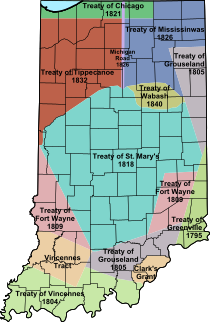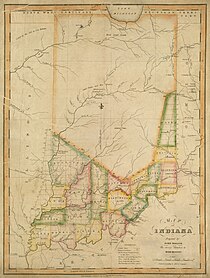Indiana
Indiana | |
|---|---|
| State of Indiana | |
| Nickname: "TheHoosierState " | |
| Motto: | |
| Anthem:"On the Banks of the Wabash, Far Away" [1] | |
 Map of the United States with Indiana highlighted | |
| Country | United States |
| Before statehood | Indiana Territory |
| Admitted to the Union | December 11, 1816 (19th) |
| Capital (and largest city) | Indianapolis |
| Largest county or equivalent | Marion |
| Largest metroandurbanareas | Indianapolis |
| Government | |
| •Governor | Eric Holcomb(R) |
| •Lieutenant Governor | Suzanne Crouch(R) |
| Legislature | General Assembly |
| •Upper house | Indiana Senate |
| •Lower house | Indiana House of Representatives |
| Judiciary | Indiana Supreme Court |
| U.S. senators |
|
| U.S. House delegation |
|
| Area | |
| • Total | 36,418 sq mi (94,321 km2) |
| • Land | 35,868 sq mi (92,897 km2) |
| • Water | 550 sq mi (1,424 km2) 1.5% |
| • Rank | 38th |
| Dimensions | |
| • Length | 270 mi (435 km) |
| • Width | 140 mi (225 km) |
| Elevation | 700 ft (210 m) |
| Highest elevation | 1,257 ft (383 m) |
| Lowest elevation | 320 ft (97 m) |
| Population (2020) | |
| • Total | 6,785,528[3] |
| • Rank | 17th |
| • Density | 189/sq mi (73.1/km2) |
| • Rank | 16th |
| •Median household income | $62,743 (2,021)[4] |
| • Income rank | 37th |
| Demonym | Hoosier |
| Language | |
| •Official language | English |
| Time zones | |
| 80 counties | UTC−05:00(Eastern) |
| • Summer (DST) | UTC−04:00(EDT) |
| 12 counties | UTC−06:00(Central) |
| • Summer (DST) | UTC−05:00(CDT) |
| USPS abbreviation | IN |
| ISO 3166 code | US-IN |
| Traditional abbreviation | Ind. |
| Latitude | 37° 46′ N to 41° 46′ N |
| Longitude | 84° 47′ W to 88° 6′ W |
| Website | in |
| List of state symbols | |
|---|---|
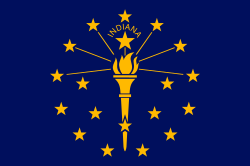 | |
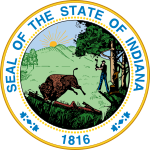 | |
| Poem | "Indiana"[5] |
| Slogan | "IN Indiana"[6] |
| Living insignia | |
| Bird | Northern cardinal[7] (Cardinalis cardinalis) |
| Flower | Peony[8] (Paeonia) |
| Insect | Say's firefly[9] (Pyractomena angulata) |
| Tree | Tulip tree[8] (Liriodendron tulipifera) |
| Inanimate insignia | |
| Color(s) | Blueandgold |
| Firearm | Grouseland Rifle[10] |
| Food | Popcorn(state snack)[11] |
| Fossil | Mastodon[12] (Mammut americanum) |
| Rock | Indiana limestone[13] |
| Other | Wabash River(state river)[13] Republic P-47 ThunderboltHoosier Spirit II(state aircraft)[14] |
| State route marker | |
 | |
| State quarter | |
 Released in 2002 | |
| Lists of United States state symbols | |
Indiana(/ˌɪndiˈænə/IN-dee-AN-ə)[15]is astatein theMidwesternregion of theUnited States.It bordersLake Michiganto the northwest,Michiganto the north and northeast,Ohioto the east, theOhio RiverandKentuckyto the south and southeast, and theWabash RiverandIllinoisto the west. Nicknamed "the Hoosier State",[16]Indiana is the38th-largest by areaand the17th-most populousof the50 states.Its capital and largest city isIndianapolis.Indiana was admitted to the Union as the 19th state on December 11, 1816.
Variousindigenous peoplesinhabited what would become Indiana for thousands of years, some of whom the U.S. government expelled between 1800 and 1836. Indiana received its name because the state was largely possessed by native tribes even after it was granted statehood. Since then, settlement patterns in Indiana have reflected regional cultural segmentation present in theEastern United States;the state's northernmost tier was settled primarily by people fromNew EnglandandNew York,Central Indiana by migrants from theMid-Atlanticstates and adjacent Ohio, andSouthern Indianaby settlers from theUpland South,particularly Kentucky andTennessee.[17]
Indiana hasa diverse economywith a gross state product of $352.62billion in 2021.[18]It has severalmetropolitan areaswith populations greater than 100,000 and a number of smaller cities and towns. Indiana is home to professional sports teams, including theNFL'sIndianapolis Coltsand theNBA'sIndiana Pacers.The state also hosts several notable competitive events, such as theIndianapolis 500,held atIndianapolis Motor Speedway.
Etymology
[edit]Indiana's name means "Land of theIndians",or simply" Indian Land ".[b]It also stems from Indiana's territorial history. On May 7, 1800, theUnited States Congresspassed legislation to divide theNorthwest Territoryinto two areas and named the western section theIndiana Territory.In 1816, when Congress passed an Enabling Act to begin the process of establishing statehood for Indiana, a part of this territorial land became the geographic area for the new state.[c][19][20]
Formal use of the wordIndianadates from 1768, when aPhiladelphia-based trading company gave its land claim in present-dayWest Virginiathe name "Indiana" in honor of its previous owners, theIroquois.Later, ownership of the claim was transferred to theIndiana Land Company,the first recorded use of the wordIndiana.But theVirginiacolony argued that it was the rightful owner of the land because it fell within its geographic boundaries. TheU.S. Supreme Courtdenied the land company's right to the claim in 1798.[21]
Hoosier
[edit]A native or resident of Indiana is known as aHoosier.[22]The etymology of this word is disputed, but the leading theory, advanced by the Indiana Historical Bureau and the Indiana Historical Society, has its origin in Virginia, Kentucky, the Carolinas, and Tennessee (theUpland South) as a term for a backwoodsman, a rough countryman, or a country bumpkin.[23][24]
History
[edit]Indigenous inhabitants
[edit]
The first inhabitants in what is now Indiana were thePaleo-Indians,who arrived about 8000 BC after the melting of the glaciers at the end of theIce Age.Divided into small groups, the Paleo-Indians werenomadswho hunted largegamesuch asmastodons.They created stone tools made out ofchertby chipping,knappingandflaking.[25]
TheArchaic period,which began between 5000 and 4000 BC, covered the next phase of indigenous culture. The people developed new tools as well as techniques to cook food, an important step in civilization. These new tools included different types of spear points and knives, with various forms ofnotches.They made ground-stone tools such as stone axes, woodworking tools and grinding stones. During the latter part of the period, they built earthworkmoundsandmiddens,which showed settlements were becoming more permanent. The Archaic period ended at about 1500 BC, although some Archaic people lived until 700 BC.[25]
TheWoodland periodbegan around 1500 BC when new cultural attributes appeared. The people created ceramics and pottery and extended their cultivation of plants. An early Woodland period group named theAdena peoplehad elegant burial rituals, featuring log tombs beneath earth mounds. In the middle of the Woodland period, theHopewell peoplebegan to develop long-range trade ofgoods.Nearing the end of the stage, the people developed highly productive cultivation and adaptation of agriculture, growing such crops ascornandsquash.The Woodland period ended around 1000 AD.[25]
TheMississippian cultureemerged, lasting from 1000 AD until the 15th century, shortly before the arrival of Europeans. During this stage, the people created large urban settlements designed according to theircosmology,with large mounds and plazas defining ceremonial and public spaces. The concentrated settlements depended on the agricultural surpluses. One such complex was theAngel Mounds.They had large public areas such as plazas and platform mounds, where leaders lived or conducted rituals. Mississippian civilization collapsed in Indiana during the mid-15th century for reasons that remain unclear.[25]
The historic Native American tribes in the area at the time of European encounter spoke different languages of theAlgonquianfamily. They included theShawnee,Miami,andIllini.Refugee tribes from eastern regions, including theDelawarewho settled in the White and Whitewater River Valleys, later joined them.
European exploration and sovereignty
[edit]
In 1679, French explorerRené-Robert Cavelier, Sieur de La Sallewas the first European to cross into Indiana after reaching present-daySouth Bendat theSt. Joseph River.[26]He returned the following year to learn about the region. French-Canadianfur traderssoon arrived, bringing blankets, jewelry, tools, whiskey and weapons to trade for skins with the Native Americans.
By 1702,Sieur Juchereauestablished the first trading post nearVincennes.In 1715,Sieur de VincennesbuiltFort MiamiatKekionga,nowFort Wayne.In 1717, another Canadian,Picote de Beletre,builtFort Ouiatenonon theWabash River,to try to control Native American trade routes fromLake Erieto theMississippi River.
In 1732, Sieur de Vincennes built a second fur trading post at Vincennes. French Canadian settlers, who had left the earlier post because of hostilities, returned in larger numbers. In a period of a few years, British colonists arrived from the East and contended against the Canadians for control of the lucrative fur trade. Fighting between the French and British colonists occurred throughout the 1750s as a result.
The Native American tribes of Indiana sided with the French Canadians during theFrench and Indian War(also known as theSeven Years' War). With British victory in 1763, the French were forced to cede to the British crown all their lands in North America east of the Mississippi River and north and west of thecolonies.
The tribes in Indiana did not give up: they capturedFort OuiatenonandFort MiamiduringPontiac's Rebellion.The British royal proclamation of 1763 designated the land west of theAppalachiansfor Native American use, and excluded British colonists from the area, which the Crown called "Indian Territory".
In 1775, theAmerican Revolutionary Warbegan as the colonists sought self-government and independence from the British. The majority of the fighting took place near the East Coast, but the Patriot military officerGeorge Rogers Clarkcalled for an army to help fight the British in the west.[27]Clark's army won significant battles and took overVincennesandFort Sackvilleon February 25, 1779.[28]
During the war, Clark managed to cut off British troops, who were attacking the eastern colonists from the west. His success is often credited for changing the course of the American Revolutionary War.[29]At the end of the war, through theTreaty of Paris,the British crown ceded their claims to the land south of the Great Lakes to the newly formed United States, including Native American lands.
The frontier
[edit]In 1787, the U.S. defined theNorthwest Territorywhich included the area of present-day Indiana. In 1800, Congress separatedOhiofrom the Northwest Territory, designating the rest of the land as theIndiana Territory.[30]PresidentThomas JeffersonchoseWilliam Henry Harrisonas the governor of the territory, andVincenneswas established as the capital.[31]After theMichigan Territorywas separated and theIllinois Territorywas formed, Indiana was reduced to its current size and geography.[30]
Starting with theBattle of Fallen Timbersin 1794 and theTreaty of Greenvillein 1795, Native American titles to Indiana lands were extinguished by usurpation, purchase, or war and treaty. About half the state was acquired in theTreaty of St. Mary'sfrom the Miami in 1818. Purchases were not complete until theTreaty of Mississinewasin 1826 acquired the last of the reserved Native American lands in the northeast.
A portrait of the Indiana frontier about 1810: The frontier was defined by theTreaty of Fort Waynein 1809, adding much of the southwestern lands around Vincennes and southeastern lands adjacent to Cincinnati, to areas along the Ohio River as part of U.S. territory. Settlements were military outposts such as Fort Ouiatenon in the northwest and Fort Miami (later Fort Wayne) in the northeast, Fort Knox and Vincennes settlement on the lower Wabash. Other settlements included Clarksville (across from Louisville), Vevay, and Corydon along the Ohio River, the Quaker Colony in Richmond on the eastern border, and Conner's Post (later Connersville) on the east central frontier. Indianapolis would not be populated for 15 more years, and central and northern Indiana Territory remained wilderness populated primarily by Indigenous communities. Only two counties in the extreme southeast, Clark and Dearborn, had been organized by European settlers. Land titles issued out of Cincinnati were sparse. Settler migration was chiefly via flatboat on the Ohio River westerly, and by wagon trails up the Wabash/White River Valleys (west) and Whitewater River Valleys (east).
In 1810, theShawneetribal chiefTecumsehand his brotherTenskwatawaencouraged other indigenous tribes in the territory to resist European settlement. Tensions rose and the U.S. authorized Harrison to launch a preemptive expedition againstTecumseh's Confederacy;the U.S. gained victory at theBattle of Tippecanoeon November 7, 1811. Tecumseh was killed in 1813 during theBattle of Thames.After his death, armed resistance to United States control ended in the region. Most Native American tribes in the state were laterremovedto west of theMississippi Riverin the 1820s and 1830s after U.S. negotiations and the purchase of their lands.[32]
Statehood and settlement
[edit]Corydon,a town in the far southern part of Indiana, was named the second capital of the Indiana Territory in May 1813 in order to decrease the threat of Native American raids following the Battle of Tippecanoe.[30]Two years later, a petition for statehood was approved by the territorial general assembly and sent to Congress. AnEnabling Actwas passed to provide an election of delegates to write aconstitution for Indiana.On June 10, 1816, delegates assembled at Corydon to write the constitution, which was completed in 19 days.Jonathan Jenningswas elected the fledgling state's first governor in August 1816. PresidentJames Madisonapproved Indiana'sadmission into the unionas thenineteenth stateon December 11, 1816.[28]In 1825, the state capital was moved from Corydon toIndianapolis.[30]
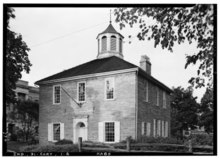 |
 |
Many Europeanimmigrantswent west to settle in Indiana in the early 19th century. The largest immigrant group to settle in Indiana wereGermans,as well as many immigrants fromIrelandandEngland.Americans who were primarilyethnically Englishmigrated from the Northern Tier of New York and New England, as well as from the mid-Atlantic state of Pennsylvania.[34][35]The arrival of steamboats on the Ohio River in 1811, and theNational Roadat Richmond in 1829, greatly facilitated settlement of northern and western Indiana.
Following statehood, the new government worked to transform Indiana from afrontierinto a developed, well-populated, and thriving state, beginning significant demographic and economic changes. In 1836, the state's founders initiated a program, theIndiana Mammoth Internal Improvement Act,that led to the construction of roads,canals,railroads and state-funded public schools. The plans bankrupted the state and were a financial disaster, but increased land and produce value more than fourfold.[36]In response to the crisis and in order to avert another, in 1851, a second constitution was adopted. Among its provisions were a prohibition on public debt, as well as the extension ofsuffrageto African-Americans.
Civil War and late 19th-century industry
[edit]During theAmerican Civil War,Indiana became politically influential and played an important role in the affairs of the nation. Indiana was the first western state to mobilize for the United States in the war, and soldiers from Indiana participated in all the war's major engagements. The state provided 126 infantry regiments, 26 batteries of artillery and 13 regiments of cavalry to theUnion.[37]
In 1861, Indiana was assigned aquotaof 7,500 soldiers to join theUnion Army.[38]So many volunteered in the first call that thousands had to be turned away. Before the war ended, Indiana had contributed 208,367 men. Casualties were over 35% among these men: 24,416 lost their lives and over 50,000 more were wounded.[39]The only Civil War conflicts fought in Indiana were theNewburgh Raid,a bloodless capture of the city; and theBattle of Corydon,which occurred duringMorgan's Raidleaving 15 dead, 40 wounded, and 355 captured.[40]
After the war, Indiana remained a largely agricultural state. Post-war industries included mining, including limestone extraction; meatpacking; food processing, such as milling grain, distilling it into alcohol; and the building ofwagons,buggies,farm machinery, and hardware.[41]However, thediscovery of natural gasin the 1880s in northern Indiana led to an economic boom: the abundant and cheap fuel attractedheavy industry;the availability of jobs, in turn, attracted new settlers from other parts of the country as well as from Europe.[42]This led to the rapid expansion of cities such asSouth Bend,Indianapolis, andFort Wayne.[41]
Early 20th century
[edit]The early decades of the 20th century saw Indiana develop into a leadingmanufacturing statewith heavy industry concentrating in the north.[34]In 1906 theUnited States Steel Corporationcreated a new industrial city on Lake Michigan,Gary,named afterElbert Henry Gary,its founding chairman. With industrialization, workers developed labor unions (their strike activities induced governorJames P. Goodrichto declare martial law in Gary in 1919)[43]and asocialist party.[44]RailroaderEugene DebsofTerre Haute,the Socialist candidate received 901,551 votes (6.0% of the national vote) in the 1912 presidential election.[45]Suffrage movements also arose to enfranchise women.[42]
In its earlier years, Indiana was a leader in the automobile boom. Beginning its production inKokomoin 1896,Haynes-Appersonwas the nation's first commercially successful auto company.[46]The importance of vehicle and parts manufacture to the state was symbolized by the construction in 1909 of theIndianapolis Motor Speedway.[47]
In the 1920s, state politics was heavily influenced by the rise of theIndiana Klan.First organized in 1915 as a branch of theKu Klux Klan,it appealed to white Protestants alarmed by social and economic trends, including changes induced by immigration from southern and central Europe.[48]In the name of defending "hundred-per-cent Americanism", the Klan sought exclude from public life "Bolsheviks,Catholics,Jews,Negroes,bootleggers,pacifists,evolutionists,foreigners, and all persons it considered immoral ".[49]
By 1925 the Klan had 250,000 members, an estimated 30% of native-born white men.[50][51]By 1925 over half the elected members of theIndiana General Assembly,thegovernor of Indiana,and many other high-ranking officials in local and state government were members of the Klan. Politicians had also learned they needed Klan endorsement to win office.[52]That year, "Grand Dragon"D.C. Stephenson,who had begun to brag "I am the law in Indiana",[53]was charged and convicted for the rape and murder ofMadge Oberholtzer,a young schoolteacher. Denied pardon, in 1927 Stephenson gave theIndianapolis Timeslists of people the Klan had paid. Partly as a result of compounded scandal, membership collapsed.[54]
Throughout the 1930s,Democratswere in power and "the Klan was political poison".[55]During those years, Indiana, like the rest of the nation, was affected by theGreat Depression.The economic downturn had a wide-ranging negative impact on Indiana, such as the decline of urbanization. TheDust Bowlto the west led many migrants to flee to the more industrialized Midwest. GovernorPaul V. McNutt's administration struggled to build a state-funded welfare system to help overwhelmed private charities. During his administration, spending and taxes were both cut drastically in response to the Depression, and the state government was completely reorganized. McNutt endedProhibitionin the state and enacted the state's first income tax. On several occasions, he declared martial law to put an end to worker strikes.[56]
World War IIhelped lift Indiana's economy, as the war required steel, food and other goods the state produced.[57]Roughly 10% of Indiana's population joined the armed forces, while hundreds of industries earned war production contracts and began making war material.[58]Indiana manufactured 4.5% of total U.S. military armaments during World WarII, ranking eighth among the 48 states.[59]The expansion of industry to meet war demands helped end the Great Depression.[57]
Modern era
[edit]With the conclusion of World WarII, Indiana rebounded to pre-Depression levels of production. Industry became the primary employer, a trend that continued into the 1960s. Urbanization during the 1950s and 1960s led to substantial growth in the state's cities. The auto, steel and pharmaceutical industries topped Indiana's major businesses. Indiana's population continued to grow after the war, exceeding five million by the 1970 census.[60]In the 1960s the administration ofMatthew E. Welshadopted its first sales tax of 2%.[61]Indiana schools weredesegregatedin 1949. In 1950, the U.S. Census Bureau reported Indiana's population as 95.5% white and 4.4% black.[62]Governor Welsh also worked with the General Assembly to pass the IndianaCivil RightsBill, granting equal protection to minorities in seeking employment.[63]
On December 8, 1964, aConvair B-58carryingnuclear weaponsslid off an icy runway onBunker Hill Air Force BaseinBunker Hill, Indianaand caught fire during a training drill. The five nuclear weapons on board were burned, including one 9-megatonthermonuclear weapon,causingradioactive contaminationof the crash area.[64]
Beginning in 1970, a series of amendments to the state constitution were proposed. With adoption, theIndiana Court of Appealswas created and the procedure of appointing justices on the courts was adjusted.[65]
The1973 oil crisiscreated a recession that hurt the automotive industry in Indiana. Companies such asDelco ElectronicsandDelphibegan a long series of downsizing that contributed to high unemployment rates in manufacturing inAnderson,Muncie,andKokomo.The restructuring and deindustrialization trend continued until the 1980s when the national and state economy began to diversify and recover.[66]
Geography
[edit]
With a total area (land and water) of 36,418 square miles (94,320 km2), Indiana ranks as the 38th largest state in size.[67]The state has a maximum dimension north to south of 250 miles (400 km) and a maximum east to west dimension of 145 miles (233 km).[68]The state's geographic center (39° 53.7'N, 86° 16.0W) is inMarion County.[69]
Located in theMidwestern United States,Indiana is one of eight states that make up theGreat Lakes Region.[70]Indiana is bordered on the north byMichigan,on the east byOhio,and on the west byIllinois,partially separated by theWabash River.[71]Lake Michiganborders Indiana on the northwest and theOhio Riverseparates Indiana fromKentuckyon the south.[69][72]
Geology and terrain
[edit]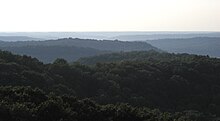
The average altitude of Indiana is about 760 feet (230 m) above sea level.[73]The highest point in the state isHoosier HillinWayne Countyat 1,257 feet (383 m) above sea level.[67][74]The lowest point at 320 feet (98 m) above sea level is inPosey County,where theWabash Rivermeets theOhio River.[67][69]The resultingelevation span,937 feet (286 m), is the narrowest of any non-coastal U.S. state. Only 2,850 square miles (7,400 km2) have an altitude greater than 1,000 feet (300 m) and this area is enclosed within 14 counties. About 4,700 square miles (12,000 km2) have an elevation of less than 500 feet (150 m), mostly concentrated along the Ohio and lower Wabash Valleys, fromTell CityandTerre HautetoEvansvilleandMount Vernon.[75]
The state includes two natural regions of the United States: the Central Lowlands and theInterior Low Plateaus.[76] Thetill plainsmake up the northern and central regions of Indiana. Much of its appearance is a result of elements left behind byglaciers.Central Indiana is mainly flat with some low rolling hills (except where rivers cut deep valleys through the plain, like at the Wabash River and Sugar Creek) and soil composed of glacial sands, gravel and clay, which results in exceptional farmland.[71]Northern Indiana is similar, except for the presence of higher and hillierterminal morainesand hundreds ofkettle lakes.Innorthwest Indianathere are various sand ridges and dunes, some reaching nearly 200 feet in height; most of them are atIndiana Dunes National Park.These are along the Lake Michigan shoreline and also inland to theKankakee Outwash Plain.
Southern Indiana is characterized by valleys and rugged, hilly terrain, contrasting with much of the state. Here, bedrock is exposed at the surface. Because of the prevalentIndiana limestone,the area has many caves, caverns, and quarries.
Hydrology
[edit]
Major river systems in Indiana include the Whitewater, White, Blue, Wabash, St. Joseph, and Maumee rivers.[77]According to the Indiana Department of Natural Resources, as of 2007, there were 65 rivers, streams, and creeks of environmental interest or scenic beauty, which included only a portion of an estimated 24,000 total river miles within the state.[78]
TheWabash River,which is the longest free-flowing river east of theMississippi River,is the official river of Indiana.[79][80]At 475 miles (764 kilometers) in length, the river bisects the state from northeast to southwest, forming part of the state's border with Illinois, before converging with theOhio River.The river has been the subject of several songs, such as "On the Banks of the Wabash, Far Away","Wabash Cannonball",and"Back Home Again in Indiana".[81][82]
There are about 900 lakes listed by the Indiana Department of Natural Resources.[83]To the northwest, Indiana bordersLake Michigan,one of five lakes comprising theGreat Lakes,the largest group of freshwater lakes in the world.Tippecanoe Lake,the deepest lake in the state, reaches depths at nearly 120 feet (37 m), whileLake Wawaseeis the largest natural lake in Indiana.[84]At 10,750 acres (summer pool level),Monroe Lakeis the largest lake in Indiana.[85]
Climate
[edit]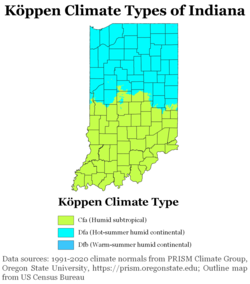
In the past, almost all of Indiana had ahumid continental climate(Dfb), with cold winters and hot, wet summers;[86]only the extreme southern portion of the state lay within thehumid subtropical climate(Cfa), which receives more precipitation than other parts of Indiana.[71]But as of the 2016 update, about half the state is now classified as humid subtropical. Temperatures generally diverge from the north and south sections of the state. In midwinter, average high/low temperatures range from around 30°F/15°F (−1°C/−10°C) in the far north to 41°F/24°F (5°C/−4°C) in the far south.[87]
In midsummer there is generally a little less variation across the state, as average high/low temperatures range from around 84°F/64°F (29°C/18°C) in the far north to 90°F/69°F (32°C/21°C) in the far south.[87]Indiana's record high temperature was 116°F (47°C) set on July 14, 1936, atCollegeville.The record low was −36°F (−38°C) onJanuary 19, 1994atNew Whiteland.[88]Thegrowing seasontypically spans from 155 days in the north to 185 days in the south.[citation needed]
While droughts occasionally occur in the state, rainfall totals are distributed relatively equally throughout the year. Precipitation totals range from 35 inches (89 cm) near Lake Michigan in northwest Indiana to 45 inches (110 cm) along the Ohio River in the south, while the state's average is 40 inches (100 cm). Annual snowfall in Indiana varies widely across the state, ranging from 80 inches (200 cm) in the northwest along Lake Michigan to 14 inches (36 cm) in the far south.Lake effect snowaccounts for roughly half the snowfall in northwest and north central Indiana due to the effects of the moisture and relative warmth of Lake Michigan upwind. The mean wind speed is 8 miles per hour (13 km/h).[89]
In a 2012 report, Indiana was ranked eighth in a list of the top 20 tornado-prone states based onNational Weather Servicedata from 1950 through 2011.[90]A 2011 report rankedSouth Bend15th among the top 20 tornado-prone U.S. cities,[91]while another report from 2011 rankedIndianapoliseighth.[92][d][e]Despite its vulnerability, Indiana is not part ofTornado Alley.[93]
| Average precipitation in Indiana[94] | ||||||||||||
| Jan | Feb | Mar | Apr | May | Jun | Jul | Aug | Sep | Oct | Nov | Dec | Annum |
|---|---|---|---|---|---|---|---|---|---|---|---|---|
| 2.48 | 2.27 | 3.36 | 3.89 | 4.46 | 4.19 | 4.22 | 3.91 | 3.12 | 3.02 | 3.44 | 3.13 | 41.49 |
| Location | July (°F) | July (°C) | January (°F) | January (°C) |
|---|---|---|---|---|
| Indianapolis | 85/66 | 29/19 | 35/20 | 2/−6 |
| Fort Wayne | 84/62 | 29/17 | 32/17 | 0/−8 |
| Evansville | 88/67 | 31/19 | 41/24 | 5/−4 |
| South Bend | 83/63 | 28/17 | 32/18 | 0/−8 |
| Bloomington | 87/65 | 30/18 | 39/21 | 4/−6 |
| Lafayette | 84/62 | 29/17 | 31/14 | 0/−10 |
| Muncie | 85/64 | 29/18 | 34/19 | 1/−7 |
Time zones
[edit]Indiana is one of 13 U.S. states that are divided into more than one time zone. Indiana'stime zoneshave fluctuated over the past century. At present most of the state observesEastern Time;six counties near Chicago and six near Evansville observeCentral Time.[96]Debate continues on the matter.[97]
Before 2006, most of Indiana did not observedaylight saving time(DST). Some counties within this area, particularlyFloyd,Clark,andHarrisoncounties nearLouisville, Kentucky,andOhioandDearborncounties nearCincinnati,Ohio, unofficially observed DST by local custom. Since April 2006 the entire state observes DST.[98]
Indiana counties and statistical areas
[edit]Indiana is divided into 92counties.As of 2010[update],the state includes 16metropolitanand 25micropolitan statistical areas,117 incorporated cities, 450 towns, and several other smaller divisions and statistical areas.[99][f]Marion Countyand Indianapolis have aconsolidated city-county government.[99]
Major cities
[edit]Indianapolis is the capital of Indiana and its largest city.[99][g]Indiana's four largest metropolitan areas areIndianapolis,Fort Wayne,Evansville,andSouth Bend.[100]The table below lists the state's twenty largest municipalities based on the 2020 United States census.[101]
| Rank | Name | County | Pop. | Rank | Name | County | Pop. | ||
|---|---|---|---|---|---|---|---|---|---|
 Indianapolis  Fort Wayne |
1 | Indianapolis | Marion | 887,642 | 11 | Gary | Lake | 69,093 |  Evansville  South Bend |
| 2 | Fort Wayne | Allen | 263,886 | 12 | Muncie | Delaware | 65,194 | ||
| 3 | Evansville | Vanderburgh | 117,298 | 13 | Greenwood | Johnson | 63,830 | ||
| 4 | South Bend | St. Joseph | 103,453 | 14 | Kokomo | Howard | 59,604 | ||
| 5 | Carmel | Hamilton | 99,757 | 15 | Terre Haute | Vigo | 58,389 | ||
| 6 | Fishers | Hamilton | 98,977 | 16 | Anderson | Madison | 54,788 | ||
| 7 | Bloomington | Monroe | 79,168 | 17 | Elkhart | Elkhart | 53,923 | ||
| 8 | Hammond | Lake | 77,879 | 18 | Mishawaka | St. Joseph | 51,063 | ||
| 9 | Lafayette | Tippecanoe | 70,783 | 19 | Columbus | Bartholomew | 50,474 | ||
| 10 | Noblesville | Hamilton | 69,604 | 20 | Jeffersonville | Clark | 49,447 | ||
Demographics
[edit]Population
[edit]| Census | Pop. | Note | %± |
|---|---|---|---|
| 1800 | 2,632 | — | |
| 1810 | 24,520 | 831.6% | |
| 1820 | 147,178 | 500.2% | |
| 1830 | 343,031 | 133.1% | |
| 1840 | 685,866 | 99.9% | |
| 1850 | 988,416 | 44.1% | |
| 1860 | 1,350,428 | 36.6% | |
| 1870 | 1,680,637 | 24.5% | |
| 1880 | 1,978,301 | 17.7% | |
| 1890 | 2,192,404 | 10.8% | |
| 1900 | 2,516,462 | 14.8% | |
| 1910 | 2,700,876 | 7.3% | |
| 1920 | 2,930,390 | 8.5% | |
| 1930 | 3,238,503 | 10.5% | |
| 1940 | 3,427,796 | 5.8% | |
| 1950 | 3,934,224 | 14.8% | |
| 1960 | 4,662,498 | 18.5% | |
| 1970 | 5,193,669 | 11.4% | |
| 1980 | 5,490,224 | 5.7% | |
| 1990 | 5,544,159 | 1.0% | |
| 2000 | 6,080,485 | 9.7% | |
| 2010 | 6,483,802 | 6.6% | |
| 2020 | 6,785,528 | 4.7% | |
| 2023 (est.) | 6,862,199 | [102] | 1.1% |
| Source: 1910–2020[103] | |||
Indiana recorded a population of 6,785,528 in the2020 United States census,a 4.65% increase since the2010 United States census.[3]
The state's population density was 181.0 persons per square mile, the 16th-highest in the United States.[99]As of the 2010 U.S. census, Indiana's population center is northwest of Sheridan, inHamilton County(+40.149246, −086.259514).[99][104][h]
In 2005, 77.7% of Indiana residents lived in metropolitan counties, 16.5% lived in micropolitan counties and 5.9% lived in non-core counties.[105]
According toHUD's 2022Annual Homeless Assessment Report,there were an estimated 5,449homelesspeople in Indiana.[106][107]
In 2018, the top countries of origin for Indiana's immigrants wereMexico,India,China,Myanmar,and thePhilippines.[108]
Ancestry
[edit]
| Race and ethnicity[109] | Alone | Total | ||
|---|---|---|---|---|
| White (non-Hispanic) | 75.5% | 79.1% | ||
| African American (non-Hispanic) | 9.4% | 10.8% | ||
| Hispanic or Latino[i] | — | 8.2% | ||
| Asian | 2.5% | 3.1% | ||
| Native American | 0.2% | 1.6% | ||
| Pacific Islander | 0.04% | 0.2% | ||
| Other | 0.4% | 1.1% | ||
| Racial composition | 1990[110] | 2000[111] | 2010[112] | 2020[113] |
|---|---|---|---|---|
| White | 90.6% | 87.5% | 84.3% | 77.2% |
| Black | 7.8% | 8.4% | 9.1% | 9.6% |
| Asian | 0.7% | 1.0% | 1.6% | 2.5% |
| Native | 0.2% | 0.3% | 0.3% | 0.4% |
| Native Hawaiianand other Pacific Islander |
– | – | – | – |
| Other race | 0.7% | 1.6% | 2.7% | 3.9% |
| Two or more races | – | 1.2% | 2.0% | 6.4% |
Germanis the largest ancestry reported in Indiana, with 18.8% of the population reporting that ancestry in the census. Persons listing themselves asAmerican(7.2%) and those ofEnglishancestry (11.1%) are also numerous, as areIrish(9.8%) andPolish(2.6%).[114]Most of those citing American ancestry are actually of European descent, including many ofEnglishdescent, but have family that has been in North America for so long, in many cases since the earlycolonial era,that they identify simply as American.[115][116][117][118]In the 1980 census 1,776,144 people claimed German ancestry, 1,356,135 claimed English ancestry and 1,017,944 claimed Irish ancestry out of a total population of 4,241,975 making the state 42% German, 32% English and 24% Irish.[119]
The state is home to a growing Hispanic population, making up 7.8% of the total population. The largest Hispanic ancestry in the state is Mexican (5.3%), making up a large majority of the Hispanic population.[120]
The majority (62%) of the state'sAfrican Americanpopulation is concentrated in Marion and Lake counties, in and around the cities ofIndianapolisandGary.[121]
Population growth
[edit]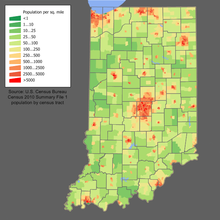

| Non-Hispanic White 50–60% 60–70% 70–80% 80–90% 90%+ |
Population growth since 1990 has been concentrated in the counties surrounding Indianapolis, with four of the five fastest-growing counties in that area:Hamilton,Hendricks,Johnson,andHancock.The other county isDearborn County,which is nearCincinnati,Ohio.Hamilton County has also grown faster than any county in the states bordering Indiana (Illinois,Michigan,OhioandKentucky), and is the 20th-fastest growing county in the country.[122]
With a population of 829,817,Indianapolisis the largest city in Indiana and the 12th-largest in the United States, according to the 2010 census. Three other cities in Indiana have a population greater than 100,000:Fort Wayne(253,617),Evansville(117,429) andSouth Bend(101,168).[123]Since 2000,Fishershas seen the largest population rise amongst the state's twenty largest cities with an increase of 100%.[124]Other cities that have seen extensive growth since 2000 areGreenwood(81%),Noblesville(39.4%),Carmel(21.4%),Columbus[125](12.8%) andLawrence(9.3%).
GaryandHammondhave had the largest population declines regarding the 20 largest cities since 2000, with a decrease of 21.0% and 6.8% respectively.[124]Evansville(−4.2%),Anderson(−4.0%) andMuncie(−3.9%) have also had declines.[126]
Indianapolis has the largest population of the state'smetropolitan areasand the33rd-largestin the country.[127]TheIndianapolis metropolitan areaencompassesMarion Countyand nine surrounding counties in central Indiana.
Note: Births in table don't add up, because Hispanics are counted both by their ethnicity and by their race, giving a higher overall number.
| Race | 2013[128] | 2014[129] | 2015[130] | 2016[131] | 2017[132] | 2018[133] | 2019[134] | 2020[135] | 2021[136] | 2022[137] |
|---|---|---|---|---|---|---|---|---|---|---|
| White: | 70,166 (84.4%) | 70,967 (84.4%) | 70,741 (84.1%) | ... | ... | ... | ... | ... | ... | ... |
| >Non-Hispanic White | 63,820 (76.8%) | 64,076 (76.2%) | 63,472 (75.5%) | 62,039 (74.7%) | 60,515 (73.6%) | 59,520 (72.9%) | 58,211 (72.0%) | 56,290 (71.6%) | 56,839 (71.1%) | 55,178 (69.3%) |
| Black | 10,445 (12.6%) | 10,666 (12.7%) | 10,656 (12.7%) | 9,768 (11.8%) | 9,971 (12.1%) | 10,242 (12.5%) | 10,249 (12.7%) | 9,848 (12.5%) | 9,991 (12.5%) | 10,119 (12.7%) |
| Asian | 2,364 (2.8%) | 2,322 (2.8%) | 2,523 (3.0%) | 2,426 (2.9%) | 2,535 (3.1%) | 2,382 (2.9%) | 2,285 (2.8%) | 2,335 (3.0%) | 2,295 (2.9%) | 2,458 (3.1%) |
| American Indian | 127 (0.1%) | 125 (0.1%) | 120 (0.1%) | 85 (0.1%) | 124 (0.2%) | 132 (0.2%) | 117 (0.1%) | 56 (>0.1%) | 76 (>0.1%) | 126 (0.2%) |
| Hispanic(of any race) | 6,837(8.2%) | 7,239(8.6%) | 7,634(9.1%) | 7,442(8.9%) | 7,669(9.3%) | 7,867(9.6%) | 8,420(10.4%) | 8,480(10.8%) | 8,826(11.0%) | 9,939(12.5%) |
| Total Indiana | 83,102(100%) | 84,080(100%) | 84,040(100%) | 83,091(100%) | 82,170(100%) | 81,646(100%) | 80,859(100%) | 78,616(100%) | 79,946(100%) | 79,649(100%) |
- Since 2016, data for births ofWhite Hispanicorigin are not collected, but included in oneHispanicgroup; persons of Hispanic origin may be of any race.
Based on population estimates for 2011, 6.6% of the state's population is under the age of five, 24.5% is under the age of 18, and 13.2% is 65 years of age or older.[138]From the 2010 U.S. census demographic data for Indiana, the median age is 37.[139]
Median income
[edit]
As of the2010 census,Indiana's median household income was $44,616, ranking it 36th among the United States and the District of Columbia.[140]In 2005, the median household income for Indiana residents was $43,993. Nearly 498,700 Indiana households had incomes between $50,000 and $75,000, accounting for 20% of all households.[141]
Hamilton County's median household income is nearly $35,000 higher than the Indiana average. At $78,932, it ranks seventh in the country among counties with fewer than 250,000 people. The next highest median incomes in Indiana are also found in the Indianapolis suburbs; Hendricks County has a median of $57,538, followed by Johnson County at $56,251.[141]
Religion
[edit]
Although the largest single religious denomination in the state is Catholic (747,706 members), most Hoosiers are members of various Protestant denominations. The largest Protestant denomination by number of adherents in 2010 was theUnited Methodist Church,with 355,043.[143]A study by the Graduate Center at theCity University of New Yorkfound 20% are Catholic, 14% belong toBaptistchurches, 10% are other Christians, 9% areMethodist,and 6% areLutheran.The study found 16% are affiliated withno religion.[144]
Indiana is home to theBenedictineSt. Meinrad Archabbey,one of two Catholicarchabbeysin the United States and 11 in the world. TheLutheran Church–Missouri Synodhas one of its two seminaries inFort Wayne.Two evangelical Methodist denominations, theFree Methodist Churchand theWesleyan Church,are headquartered in Indianapolis, as is theChristian Church.[145][146]
TheFellowship of Grace Brethren Churchesmaintains offices and publishing work inWinona Lake.[147]Huntingtonserves as the home to theChurch of the United Brethren in Christ.[148]Andersonis home to the headquarters of theChurch of God.[149]The headquarters of theMissionary Churchis in Fort Wayne.[150]
TheFriends United Meetingof theReligious Society of Friends,the largest branch of American Quakerism, is based inRichmond,[151]which also houses the oldest Quaker seminary in the United States, theEarlham School of Religion.[152]TheIslamic Society of North Americais headquartered inPlainfield.[153]
| Affiliation | % of Indiana population | |
|---|---|---|
| Christianity | 72 | |
| Protestant | 52 | |
| Evangelical Protestant | 31 | |
| Mainline Protestant | 16 | |
| Black Protestant | 5 | |
| Catholic | 18 | |
| Mormon | 1 | |
| Jehovah's Witnesses | 0.5 | |
| Orthodox | 0.5 | |
| Other Christianity | 0.5 | |
| Judaism | 1 | |
| Buddhism | 0.5 | |
| Islam | 0.5 | |
| Hinduism | 0.5 | |
| Other faiths | 1 | |
| Unaffiliated | 26 | |
| Don't know / no answer | 0.5 | |
Law and government
[edit]
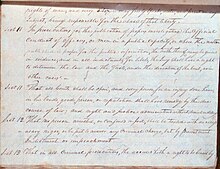
Indiana has a constitutional democratic republican form of government with three branches: the executive, including an elected governor and lieutenant governor; the legislative, consisting of an electedbicameralGeneral Assembly; and the judicial, the Supreme Court of Indiana, the Indiana Court of Appeals and circuit courts.
TheGovernor of Indianaserves as the state's chief executive and has the authority to manage the government as established in the Constitution of Indiana. The governor and thelieutenant governorare jointly elected to four-year terms, with gubernatorial elections running concurrently with United States presidential elections (1996, 2000, 2004, 2008, etc.).[155]The governor may not serve more than two consecutive terms.[155]The governor works with theIndiana General Assemblyand theIndiana Supreme Courtto govern the state and has the authority to adjust the other branches. The governor can call special sessions of the General Assembly and select and remove leaders of nearly all state departments, boards and commissions. Other notable powers include calling out theIndiana Guard Reserveor theIndiana National Guardin times of emergency or disaster, issuing pardons or commuting the sentence of any criminal offenders except in cases of treason or impeachment and possessing an abundant amount of statutory authority.[155][156][157]
The lieutenant governor serves as the President of the Senate and ensures the senate rules are acted in accordance with by its constituents. The lieutenant governor votes only when needed to break ties. If the governor dies in office, becomes permanently incapacitated, resigns or is impeached, the lieutenant governor becomes governor. If both the governor and lieutenant governor positions are unoccupied, the Senate President pro tempore becomes governor.[158]
The Indiana General Assembly is composed of a 50-memberSenateand 100-memberHouse of Representatives.The Senate is theupper houseof the General Assembly and the House of Representatives is thelower house.[155]The General Assembly has exclusive legislative authority within the state government. Both the Senate and the House can introduce legislation, with the exception that the Senate is not authorized to initiate legislation that will affect revenue. Bills are debated and passed separately in each house, but both houses must pass them before they can be submitted to the Governor.[159]The legislature can nullify a veto from the governor with a majority vote of full membership in the Senate and House of Representatives.[155]Each law passed by the General Assembly must apply without exception to the entire state. The General Assembly has no authority to create legislation that targets a particular community.[159][160]The General Assembly can manage the state's judiciary system by arranging the size of the courts and the bounds of their districts. It also can oversee the activities of the executive branch of the state government, has restricted power to regulate the county governments within the state, and has exclusive power to initiate the method to alter the Indiana Constitution.[159][161]
TheIndiana Supreme Courtis made up of five judges with aCourt of Appealscomposed of 15 judges. The governor selects judges for the supreme and appeals courts from a group of applicants chosen by a special commission. After serving for two years, the judges must acquire the support of the electorate to serve for a 10-year term.[155]In nearly all cases, the Supreme Court does not haveoriginal jurisdictionand can hear only cases petitioned to it after being heard in lower courts. Local circuit courts are where most cases begin with a trial and the consequence is decided by the jury. The Supreme Court has original and sole jurisdiction in certain areas including the practice of law, discipline or disbarment of Judges appointed to the lower state courts, and supervision over the exercise of jurisdiction by the other lower courts of the State.[162][163]
The state is divided into 92counties,which are led by a board of county commissioners. 90 counties in Indiana have their owncircuit courtwith a judge elected for a six-year term. The remaining two counties, Dearborn and Ohio, are combined into one circuit. Many counties operatesuperior courtsin addition to the circuit court. In densely populated counties where the caseload is traditionally greater, separate courts have been established to solely hear either juvenile, criminal, probate or small claims cases. The establishment, frequency and jurisdiction of these additional courts vary greatly from county to county. There are 85 city and town courts in Indiana municipalities, created by local ordinance, typically handling minor offenses and not consideredcourts of record.County officials elected to four-year terms include an auditor, recorder, treasurer, sheriff, coroner and clerk of the circuit court. All incorporated cities in Indiana have a mayor and council form of municipal government. Towns are governed by a town council and townships are governed by a township trustee and advisory board.[155][164]
U.S. News & World Reportranked Indiana first in the publication's inaugural 2017 Best States for Government listing. Among individual categories, Indiana ranked above average in budget transparency (#1), government digitization (#6), and fiscal stability (#8), and ranked average in state integrity (#25).[165]
In a 2020 study, Indiana was ranked as the 10th hardest state for citizens to vote in.[166]Abortionis illegal in Indiana with limited exceptions.[167]
Military installations
[edit]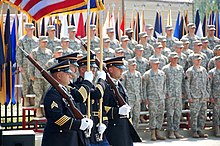
Indiana is home to several current and formermilitary installations.The largest of these is theNaval Surface Warfare Center Crane Division,approximately 25 miles southwest ofBloomington,which is the third-largest naval installation in the world, comprising approximately 108 square miles of territory.[168]Located inside NSWC Crane is Constitution Grove, a 64,000-acre forest containing approximately 120 old-growthwhite oaktrees selected for the maintenance of theUSS Constitution,the world's oldest commissioned warship still afloat.[169]
Other active installations includeAir National Guardfighter units atFort Wayne,andTerre Hauteairports (to be consolidated at Fort Wayne under the2005 BRAC proposal,with the Terre Haute facility remaining open as a non-flying installation). TheArmy National Guardconducts operations atCamp AtterburyinEdinburgh, Indiana,helicopter operations out ofShelbyvilleAirport and urban training atMuscatatuck Urban Training Center.The Army'sNewport Chemical Depot,which is now closed and turning into a coal purifier plant.
Indiana was formerly home to two major military installations;Grissom Air Force Basenear Peru (realigned to anAir Force Reserveinstallation in 1994) andFort Benjamin Harrisonnear Indianapolis, now closed, though theDepartment of Defensecontinues to operate a large finance center there (Defense Finance and Accounting Service).
Politics
[edit]
From 1880 to 1924, a resident of Indiana was included in all but one presidential election. Indiana RepresentativeWilliam Hayden Englishwas nominated for vice president and ran with Winfield Scott Hancock in the1880 election.[170]Former Indiana GovernorThomas A. Hendrickswas elected vice president in 1884. He served until his death on November 25, 1885, under PresidentGrover Cleveland.[171]In 1888, former Senator from IndianaBenjamin Harrisonwas elected president and served one term. He remains the only President from Indiana. Indiana SenatorCharles W. Fairbankswas elected vice president in 1904, serving under PresidentTheodore Rooseveltuntil 1909.[172]Fairbanks made another run for vice president withCharles Evans Hughesin 1916, but they both lost toWoodrow Wilsonand former Indiana GovernorThomas R. Marshall,who served as vice president from 1913 until 1921.[173]Not until 1988 did another presidential election involve a native of Indiana when SenatorDan Quaylewas elected vice president and served one term withGeorge H. W. Bush.[71]GovernorMike Pencewas elected vice president in 2016 and served one term withDonald Trump.
Indiana has long been considered aRepublicanstronghold,[174][175]particularly in Presidential races. TheCook Partisan Voting Index(CPVI) now rates Indiana as R+9. Indiana was one of only ten states to support RepublicanWendell Willkiein 1940.[71]On 14 occasions the Republican candidate has defeated the Democrat by a double-digit margin in the state, including six times where a Republican won the state by more than 20 percentage points.[176]In 2000 and 2004George W. Bushwon the state by a wide margin while the election was much closer overall. The state has supported aDemocratfor president only five times since 1900. In 1912,Woodrow Wilsonbecame the first Democrat to win the state in the 20th century, with 43% of the vote. Twenty years later,Franklin D. Rooseveltwon the state with 55% of the vote over incumbent RepublicanHerbert Hoover.Roosevelt won the state again in 1936. In 1964, 56% of voters supported DemocratLyndon B. Johnsonover RepublicanBarry Goldwater.Forty-four years later, DemocratBarack Obamanarrowly won the state againstJohn McCain50% to 49%.[177]In thefollowing election,RepublicanMitt Romneywon back the state for the Republican Party with 54% of the vote over the incumbent President Obama who won 43%.[178]
While only five Democratic presidential nominees have carried Indiana since 1900, 11 Democratswere elected governorduring that time. BeforeMitch Danielsbecame governor in 2005, Democrats had held the office for 16 consecutive years. Indiana elects two senators and nine representatives to Congress. The state has 11 electoral votes in presidential elections.[176]Seven of thedistrictsfavor the Republican Party according to the CPVI rankings; there are seven Republicans serving as representatives and two Democrats. Historically, Republicans have been strongest in the eastern and central portions of the state, while Democrats have been strongest in the northwestern part of the state. Occasionally, certain counties in the southern part of the state will vote Democratic. Marion County, Indiana's most populous county, supported the Republican candidates from 1968 to 2000, before backing the Democrats in the 2004, 2008, 2012, 2016 and 2020 elections. Indiana's second-most populous county, Lake County, strongly supports the Democratic party and has not voted for a Republican since 1972.[176]In 2005, the Bay Area Center for Voting Research rated the most liberal and conservative cities in the United States on voting statistics in the 2004 presidential election, based on 237 cities with populations of more than 100,000. Five Indiana cities were mentioned in the study. On the liberal side,Garywas ranked second andSouth Bendcame in at 83. Among conservative cities,Fort Waynewas 44th,Evansvillewas 60th andIndianapoliswas 82nd on the list.[179]
Culture
[edit]Arts
[edit]The last decades of the 19th century began what is known as the "golden age of Indiana literature", a period that lasted until the 1920s.[180]Edward EgglestonwroteThe Hoosier Schoolmaster(1871), the first best-seller to originate in the state. Many more followed, includingMaurice Thompson'sHoosier Mosaics(1875) andLew Wallace'sBen-Hur(1880). Indiana developed a reputation as the "American heartland" after the publication of several widely read novels, beginning withBooth Tarkington'sThe Gentleman from Indiana(1899),Meredith Nicholson's The Hoosiers (1900), and Thompson'sAlice of Old Vincennes(1900).[180]James Whitcomb Riley,known as the "Hoosier Poet" and the most popular poet of his age, wrote hundreds of poems with Hoosier themes, includingLittle Orphant Annie.A unique art culture also began to develop in the late 19th century, beginning theHoosier Schoolof landscape painting and theRichmond Groupof impressionist painters. The painters, includingT. C. Steele,whose work was influenced by southern Indiana's colorful hills, were known for their use of vivid colors.[180]Prominent musicians and composers from Indiana also reached national acclaim, includingPaul Dresser,whose most popular song, "On the Banks of the Wabash, Far Away",was later adopted as the official state song.[181]
Sports
[edit]Motorsports
[edit]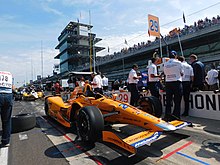
Indiana has an extensive history withauto racing.Indianapolis hosts theIndianapolis 500mile race overMemorial Dayweekend at theIndianapolis Motor Speedwayevery May. The name of the race is usually shortened to "Indy 500" and also goes by the nickname "The Greatest Spectacle in Racing". The race attracts more than 250,000 people every year, making it the largest single-day sporting event in the world. The track also hosts theBrickyard 400(NASCAR) and theRed Bull Indianapolis Grand Prix.From 2000 to 2007, it hosted theUnited States Grand Prix(Formula One). Indiana features the world's largest and most prestigiousdrag race,theNHRA Mac Tools U.S. Nationals,held eachLabor Dayweekend atLucas Oil Raceway at IndianapolisinClermont, Indiana.Indiana is also host to a majorunlimited hydroplane racingpower boat race circuits in the majorH1 Unlimitedleague, theMadison Regatta(Madison, Indiana).
Professional sports
[edit]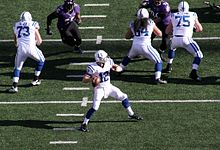
As of 2013[update]Indiana has produced moreNational Basketball Association( NBA ) players per capita than any other state. Muncie has produced the most per capita of any American city, with two other Indiana cities in the top ten.[182]It has a rich basketball heritage that reaches back to the sport's formative years. The NBA 'sIndiana Pacersplay their home games atGainbridge Fieldhouse;they began play in 1967 in theAmerican Basketball Association(ABA) and joined the NBA when the leaguesmergedin 1976. AlthoughJames Naismithdeveloped basketball inSpringfield,Massachusettsin 1891, high school basketball was born in Indiana. In 1925, Naismith visited an Indiana basketball state finals game along with 15,000 screaming fans and later wrote "Basketball really had its origin in Indiana, which remains the center of the sport." The 1986 filmHoosiersis inspired by the story of the 1954 Indiana state championsMilan High School.Professional basketball playerLarry Birdwas born inWest Baden Springsand was raised inFrench Lick.He went on to lead theBoston Celticsto the NBA championship in 1981, 1984, and 1986.[183]
Indianapolis is home to theIndianapolis Colts.The Colts are members of theSouth Divisionof theAmerican Football Conference.The Colts have roots back to 1913 as theDayton Triangles.They became an official team after moving toBaltimore,MD,in 1953. In 1984, theColtsrelocatedto Indianapolis, leading to an eventual rivalry with theBaltimore Ravens.After calling theRCA Domehome for 25 years, the Colts play their home games atLucas Oil Stadiumin Indianapolis. While in Baltimore, the Colts wonSuper Bowl V.In Indianapolis, the Colts wonSuper Bowl XLI,bringing the franchise total to two. In recent years the Colts have regularly competed in the NFL playoffs.
Indiana was home to two charter members of theNational Football Leagueteams, theHammond Prosand theMuncie Flyers.Another early NFL franchise, theEvansville Crimson Giantsspent two seasons in the league before folding.
Professional teams
[edit]The following table shows the professional sports teams in Indiana. Teams in italic are inmajor professional leagues.
The following is a table of sports venues in Indiana having a capacity in excess of 30,000:
| Facility | Capacity | Municipality | Tenants |
|---|---|---|---|
| Indianapolis Motor Speedway | 257,327 | Speedway | |
| Notre Dame Stadium | 84,000 | Notre Dame | Notre Dame Fighting Irish football |
| Lucas Oil Stadium | 62,421 | Indianapolis | Indianapolis Colts |
| Ross–Ade Stadium | 57,236 | West Lafayette | Purdue Boilermakers football |
| Memorial Stadium | 52,929 | Bloomington | Indiana Hoosiers football |
College athletics
[edit]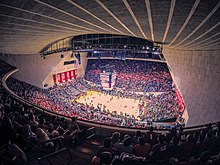
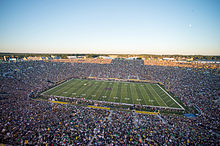
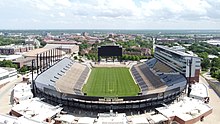
Indiana has had great sports success at the collegiate level.
In men's basketball, theIndiana Hoosiershave won five NCAA national championships and 22Big Ten Conferencechampionships. ThePurdue Boilermakerswere selected as the national champions in 1932 before the creation of the tournament, and have won 26 Big Ten championships. The Boilermakers along with the Notre Dame Fighting Irish have both won a national championship in women's basketball.
In college football, theNotre Dame Fighting Irishhave won 11 consensus national championships, as well as theRose Bowl Game,Cotton Bowl Classic,Orange BowlandSugar Bowl.Meanwhile, the Purdue Boilermakers have won 10 Big Ten championships and have won the Rose Bowl andPeach Bowl.
Schools fieldingNCAA Division Iathletic programs include:
Economy and infrastructure
[edit]

In 2017, Indiana had a civilian labor force of nearly 3.4million, the 15th largest in the United States. Indiana has an unemployment rate of 3.4%, lower than the national average.[185]The total gross state product in 2016 was $347.2billion.[186]A high percentage of Indiana's income is from manufacturing.[187]According to theBureau of Labor Statistics,nearly 17% of the state's non-farm workforce is employed in manufacturing, the highest of any state in the U.S.[188]The state's five leading exports were motor vehicles and auto parts, pharmaceutical products, industrial machinery, optical and medical equipment, and electric machinery.[189]
Despite its reliance on manufacturing, Indiana has been less affected by declines in traditionalRust Beltmanufacturers than many of its neighbors. The explanation appears to be certain factors in the labor market. First, much of the heavy manufacturing, such as industrial machinery and steel, requires highly skilled labor, and firms are often willing to locate where hard-to-train skills already exist. Second, Indiana's labor force is primarily in medium-sized and smaller cities rather than in very large and expensive metropolises. This makes it possible for firms to offer somewhat lower wages for these skills than would normally be paid. Firms often see in Indiana a chance to obtain higher than average skills at lower than average wages.[190]
Business
[edit]In 2016, Indiana was home to sevenFortune 500companies with a combined $142.5billion in revenue.[191]Columbus-basedCummins, Inc.and Indianapolis-basedEli Lilly and CompanyandSimon Property Groupwere recognized inFortunepublication's "2017 World's Most Admired Companies List", ranking in each of their respective industries.[192]
Northwest Indianahas been the largest steel producing center in the U.S. since 1975 and accounted for 27% of American-made steel in 2016.[193]
Indiana is home to the international headquarters and research facilities of pharmaceutical companyEli Lillyin Indianapolis, the state's largest corporation, as well as the world headquarters of Mead Johnson Nutritionals in Evansville.[194]Indiana ranks fifth among all U.S. states in total sales and shipments of pharmaceutical products and second in the number of biopharmaceutical related jobs.[195]
Indiana is in the U.S.Corn BeltandGrain Belt.It has a feedlot-style system raising corn to fatten hogs and cattle. Along with corn,soybeansare also a major cash crop. Its proximity to large urban centers, such asIndianapolisand Chicago, assure dairying, egg production, and specialty horticulture occur. Other crops include melons, tomatoes, grapes, mint, popping corn, and tobacco in the southern counties.[196]Most of the original land was not prairie and had to be cleared of deciduous trees. Many parcels of woodland remain and support a furniture-making sector in southern Indiana.
In 2011,CEOmagazine ranked Indiana first in the Midwest and sixth in the country for best places to do business.[197]
Taxation
[edit]Tax is collected by theIndiana Department of Revenue.[198]
Indiana has a flat stateincome taxrate of 3.23%. Many of the state's counties also collect income tax. The statesales taxrate is 7% with exemptions for food, prescription medications and over-the-counter medications.[199]In some jurisdictions, an additional Food and Beverage Tax is charged, at a rate of 1% (Marion County's rate is 2%), on sales of prepared meals and beverages.[200]
Property taxesare imposed on both real and personal property in Indiana and are administered by the Department of Local Government Finance.[201]Property is subject to taxation by a variety of ta xing units (schools, counties, townships, municipalities, and libraries), making the total tax rate the sum of the tax rates imposed by all ta xing units in which a property is located. However, a "circuit breaker" law enacted on March 19, 2008, limits property taxes to 1% of assessed value for homeowners, 2% for rental properties and farmland, and 3% for businesses.
State budget
[edit]Indiana does not have a legal requirement to balance the state budget either in law or its constitution. Instead, it has a constitutional ban on assuming debt. The state has aRainy Day Fundand for healthy reserves proportional to spending. Indiana is one of six U.S. states to not allow aline-item veto.[202]
Since 2010, Indiana has been one of a few states to holdAAA bond credit ratingswith theBig Threecredit rating agencies, the highest possible rating.[203]
Energy
[edit]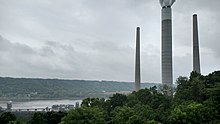
Indiana's power production chiefly consists of the consumption of fossil fuels, mainly coal. It has 24 coal power plants, including the country's largest coal power plant,Gibson Generating Station,across the Wabash River fromMount Carmel, Illinois.Indiana is also home to the coal-fired plant with the highest sulfur dioxide emissions in the United States, theGallagherpower plant, just west of New Albany.[205]
In 2010, Indiana had estimated coal reserves of 57 billion tons, and state mining operations produced 35 million tons of coal annually.[206]Indiana also has at least 900 million barrels of petroleum reserves in theTrenton Field,though they are not easily recoverable. While Indiana has made commitments to increasing the use of renewable resources such as wind, hydroelectric, biomass, or solar power, progress has been very slow, mainly because of the continued abundance of coal in southern Indiana. Most of the new plants in the state have beencoal gasificationplants. Another source is hydroelectric power.
Wind powerhas been growing rapidly. Estimates in 2006 raised Indiana's wind capacity from 30 MW at 50 m turbine height to 40,000 MW at 70 m, and to 130,000 MW at 100 m, in 2010, the height of newer turbines.[207]By the end of 2011, Indiana had installed 1,340 MW of wind turbines.[208]In 2020, this total had more than doubled to 2,968 MW.[209]
Transportation
[edit]Airports
[edit]Indianapolis International Airportserves the greater Indianapolis area. It opened in November 2008 and offers a midfield passenger terminal, concourses, air traffic control tower, parking garage, and airfield and apron improvements.[210]
Other major airports includeEvansville Regional Airport,Fort Wayne International Airport(which houses the122d Fighter Wingof theAir National Guard), andSouth Bend International Airport.A long-standing proposal to turnGary Chicago International Airportinto Chicago's third major airport received a boost in early 2006 with the approval of $48million in federal funding over the next ten years.[211]
No airlines operate out ofTerre Haute Regional Airportbut it is used primarily for general aviation. Since 1954, the181st Fighter Wingof the IndianaAir National Guardwas stationed there, but theBase Realignment and Closure(BRAC) Proposal of 2005 stated the 181st would lose its fighter mission andF-16aircraft, leaving the Terre Haute facility a general-aviation-only facility.
Louisville International Airport,across the Ohio River inLouisville, Kentucky,serves southern Indiana, as doesCincinnati/Northern Kentucky International AirportinHebron, Kentucky.Many residents ofNorthwest Indiana,which is primarily in theChicago Metropolitan Area,use Chicago's airports,O'Hare International AirportandChicago Midway International Airport.[citation needed]
Highways
[edit]
The U.S.Interstate highways in IndianaareI-64,I-65,I-265,I-465,I-865,I-69,I-469,I-70,I-74,I-80,I-90,I-94,andI-275.The various highways intersecting in and aroundIndianapolis,along with its historical status as a major railroad hub, and the canals that once crossed Indiana, are the source of the state's motto, the Crossroads of America. There are also manyU.S. routesandstate highwaysmaintained by theIndiana Department of Transportation.These are numbered according to the same convention asU.S. Highways.Indiana allows highways of different classifications to have the same number. For example, I-64 andIndiana State Road 64both exist (rather close to each other) in Indiana, but are two distinct roads with no relation to one another.
A $3 billion project extending I-69 is underway. The project was divided into six sections, with the first five sections (linkingEvansvilletoMartinsville) now complete. The sixth and final phase from Martinsville to Indianapolis is under construction. When complete, I-69 will traverse an additional 142 miles (229 km) through the state.[212]
County roads
[edit]Most Indiana counties use a grid-based system to identify county roads; this system replaced the older arbitrary system of road numbers and names, and (among other things) makes it much easier to identify the sources of calls placed to the9-1-1system. Such systems are easier to implement in the glacially flattened northern and central portions of the state. Rural counties in the southern third of the state are less likely to have grids and more likely to rely on unsystematic road names (for example, Crawford, Harrison, Perry, Scott, and Washington Counties).
There are also counties in the northern portions of the state that have never implemented a grid or have only partially implemented one. Some counties are also laid out in an almost diamond-like grid system (e.g., Clark, Floyd, Gibson, and Knox Counties). Such a system is also almost useless in those situations as well. Knox County once operated two different grid systems for county roads because the county was laid out using two different survey grids, but has since decided to use road names and combine roads instead.
Notably, the county road grid system of St. Joseph County, whose major city is South Bend, uses perennial (tree) names (i.e. Ash, Hickory, Ironwood, etc.) in Alpha betical order for north–south roads and presidential and other noteworthy names (i.e., Adams, Edison, Lincoln Way, etc.) in Alpha betical order for east–west roads. There are exceptions to this rule in downtown South Bend and Mishawaka. Hamilton County's east–west roads continue Indianapolis's numbered street system from 96th Street at the Marion County line to 296th street at the Tipton County line.
Rail
[edit]
Indiana has more than 4,255 railroad route miles (6,848 km), of which 91% are operated byClass I railroads,principallyCSX Transportationand theNorfolk Southern Railway.Other ClassI railroads in Indiana include theCanadian National RailwayandSoo Line Railroad,aCPKCsubsidiary, as well asAmtrak.The remaining miles are operated by 37 regional, local, and switching and terminal railroads. TheSouth Shore Lineis one of the country's most notable commuter rail systems, extending from Chicago toSouth Bend.Indiana is implementing an extensive rail plan prepared in 2002 by theParsons Corporation.[213]Many recreational trails, such as theMonon TrailandCardinal Greenway,have been created fromabandoned rails routes.
Ports
[edit]
Indiana annually ships more than 70 million tons of cargo by water each year, which ranks 14th among all U.S. states.[214]More than half of Indiana's border is water, which includes 400 miles (640 km) of direct access to two major freight transportation arteries: the Great Lakes/St. Lawrence Seaway (via Lake Michigan) and the Inland Waterway System (via the Ohio River). ThePorts of Indianamanages three major ports which includeBurns Harbor,Jeffersonville,andMount Vernon.[215]
Education
[edit]Public schools
[edit]
Indiana's 1816 constitution was the first in the country to implement a state-fundedpublic schoolsystem. It also allotted one township for a public university.[217]However, the plan turned out to be far too idealistic for a pioneer society, as tax money was not accessible for its organization. In the 1840s,Caleb Millspressed the need for tax-supported schools, and in 1851 his advice was included in the new state constitution. In 1843 the Legislature ruled that African Americans could not attend the public schools, leading to the foundation ofUnion Literary Instituteand other schools for them, funded by donations or the students themselves.[218]The Indiana General Assembly authorized separate but equal schools for Black students in 1869, and in 1877 language in the law changed to allow for integrated schools.[218]
Although the growth of the public school system was held up by legal entanglements, many public elementary schools were in use by 1870. Most children in Indiana attend public schools, but nearly ten percent attend private schools andparochial schools.[219]About half of all college students in Indiana are enrolled in state-supported four-year schools.
Indiana public schools have gone through several changes throughout Indiana's history. Modern, public school standards, have been implemented all throughout the state. These new standards were adopted in April 2014. The overall goal of these new state standards is to ensure Indiana students have the necessary skills and requirements needed to enter college or the workforce upon high school graduation.[220]State standards can be found for nearly every major subject taught in Indiana public schools. Mathematics, English/Language Arts, Science, and Social Studies are among the top, prioritized standards. In 2022, theIndiana Department of Educationreported that the state's overall graduation rate was 86.7%, down one percent from 2021.[221]
The rate of Indiana high school students attending college fell to 53% in 2022, a significant decline from 65% in 2017.[222][223]Indiana's college-going rates have fallen further than most states'.[224][225][226]Trends reveal widening gaps for ethnic minorities and low-income families.[225]
Vocational schools
[edit]Indiana has a strong vocational school system.Charles Allen Prossor,known as the father ofvocational educationin the United States, was fromNew Albany.TheCharles Allen Prosser School of Technologyis named in his honor. There are vocational schools in every region of Indiana, and most Indiana students can freely attend a vocational school during their high school years and receive training and job placement assistance in trade jobs. The International Union Of Operating Engineers (IUOE) has seven local unions in Indiana, offering apprenticeship and training opportunities.[227]According to the Electrical Training Alliance website, there are ten electrical training centers in Indiana.[228]
Colleges and universities
[edit]The state's community college system,Ivy Tech Community College of Indiana,serves nearly 200,000 students annually, making it the state's largest public post-secondary educational institution and the nation's largest singly accredited statewide community college system.[229]In 2008, the Indiana University system agreed to shift most of its associate (2-year) degrees to the Ivy Tech Community College System.[230]
The largest non-community educational institution isIndiana University,a multi-campus university system; itsflagship campus at Bloomingtonwas endorsed as the Indiana Seminary in 1820.Indiana State Universitywas established in Terre Haute as the state'sNormal Schoolin 1865.Purdue Universitywas chartered in West Lafayette as the state'sland-grant universityin 1869 and is also now a multi-campus institution. The three other independent state universities areVincennes University(founded in 1801 by the Indiana Territory),Ball State University(founded 1918 as the East Division of Indiana State), and theUniversity of Southern Indiana(founded 1965 as the Evansville campus of Indiana State).
Many of Indiana's private colleges and universities are affiliated with religious organizations. TheUniversity of Notre Dame,Marian University,and theUniversity of Saint FrancisareRoman Catholic schools.Universities affiliated with Protestant denominations includeAnderson University,Butler University,Huntington University,Manchester University,Indiana Wesleyan University,Taylor University,Franklin College,Hanover College,DePauw University,Earlham College,Valparaiso University,theUniversity of Indianapolis,[155]and theUniversity of Evansville.[231]
The state has several universities ranked among the best byU.S. News & World Report.The University of Notre Dame ranks among the top 20, Purdue University among the top 50, and Indiana University Bloomington among the top 100.[232][233][234]Indiana University–Purdue University Indianapolis(IUPUI) has recently made it into the top 200U.S. News & World Reportrankings. Butler, Valparaiso, and the University of Evansville are ranked among the top ten in the Regional University Midwest Rankings. Purdue's engineering programs are ranked fourth in the country.[235]In addition, Taylor University is ranked first in the Regional College Midwest Rankings andRose-Hulman Institute of Technologyhas been considered the nation's top undergraduate engineering school for 25 consecutive years.[236][237][238][239][240]In 2023, the University of Notre Dame had theseventh largest endowmentamong private postsecondary institutions in the U.S. (11th overall).
The state is also home to the largestmedical schoolsystem in the country (theIndiana University School of Medicine) and a smaller,osteopathicmedical school (Marian University'sTom and Julie Wood College of Osteopathic Medicine). In addition, Indiana boasts oneveterinary medicalschool (the Purdue College of Veterinary Medicine), oneoptometryschool (Indiana University School of Optometry), threepharmacyschools (thePurdue College of Pharmacy,Butler College of Pharmacy and Health Sciences, and the Manchester College of Pharmacy, Natural, and Health Sciences) and fourlaw schools(IU Maurer School of Law,IU McKinney School of Law,Notre Dame Law School,andPurdue Global Law School).
Sister jurisdictions
[edit]Indiana has three official partner jurisdictions:[241]
 Zhe gian g,China (1987)
Zhe gian g,China (1987) Tochigi Prefecture,Japan (1999)
Tochigi Prefecture,Japan (1999) Karnataka,India (2017)
Karnataka,India (2017)
See also
[edit]Notes
[edit]- ^abElevation adjusted toNorth American Vertical Datum of 1988.
- ^An earlier use of the name dates to the 1760s, when it referenced a tract of land under control of the Commonwealth of Virginia, but the area's name was discarded when it became a part of that state. SeeHodgin, Cyrus (1903)."The Naming of Indiana"(PDF transcription).Papers of the Wayne County, Indiana, Historical Society.1(1): 3–11.RetrievedJanuary 23,2014.
- ^A portion of the Northwest Territory's eastern section became the state ofOhioin 1803. TheMichigan Territorywas established in 1805 from part of the Indiana Territory's northern lands and four years later, in 1809, the Illinois counties were separated from the Indiana Territory to create theIllinois Territory.SeeJohn D. Barnhart; Dorothy L. Riker (1971).Indiana to 1816: The Colonial Period.The History of Indiana. Vol. I. Indianapolis: Indiana Historical Bureau and the Indiana Historical Society. pp. 311–13, 337, 353, 355, 432.
- ^In a 2008 report, Indiana was listed as one of the most tornado-prone states, ranking sixth, while South Bend was ranked the 14th most tornado-prone U.S. city, ahead of cities such asHouston,Texas, andWichita, Kansas.SeeMecklenburg, Rick (May 1, 2008)."Is Indiana the new Tornado Alley?".SouthBendTribune. Archived fromthe originalon January 17, 2013.RetrievedAugust 13,2012.
- ^In a published list of the most tornado-prone states and cities in April 2008, Indiana came in first and South Bend ranked 16th. SeeHenderson, Mark (May 2, 2008)."Top 20 Tornado Prone Cities and States Announced".WIFR.Archived fromthe originalon November 9, 2008.RetrievedAugust 17,2009.
- ^A 2008 news report indicated there were 13 metropolitan areas in Indiana. SeeDresang, Joel (July 30, 2008)."Automaking down, unemployment up".Milwaukee Journal Sentinel.RetrievedAugust 14,2009.
- ^Indiana's territorial capitals wereVincennesand laterCorydon,which also became Indiana's firststate capitalwhen it became a state.
- ^Over the previous decade, Indiana's population center has shifted slightly to the northwest. In the 2000 U.S. Census, Indiana'scenter of populationwas located inHamilton County,in the town ofSheridan.See"Population and Population Centers by State".United States Census Bureau. Archived fromthe originalon May 8, 2013.RetrievedNovember 21,2006.
- ^Persons of Hispanic or Latino origin are not distinguished between total and partial ancestry.
References
[edit]- ^"Indiana State Song".in.gov.Indiana Historical Bureau. December 7, 2020.RetrievedNovember 6,2022.
The song entitled, "On the Banks of the Wabash, Far Away," words and music by Paul Dresser, be and is hereby established as the state song of Indiana. (Ind. Code § 1-2-6-1)
- ^ab"Elevations and Distances in the United States".United States Geological Survey.2001.RetrievedOctober 21,2011.
- ^abResident Population Data."Resident Population Data – 2020 Census"(PDF).United States Census Bureau.
- ^"Median Annual Household Income".The Henry J. Kaiser Family Foundation.November 17, 2022.RetrievedApril 8,2023.
- ^"Indiana State Poem".in.gov.Indiana Historical Bureau. December 7, 2020.RetrievedNovember 6,2022.
The poem of Arthur Franklin Mapes, Kendallville, Indiana, the title and text of which are set forth in full as a part of this section, is hereby adopted as Indiana's official poem. (Ind. Code § 1-2-5-1)
- ^Kane, Lizzie (June 8, 2022)."'IN Indiana': State launches tourism campaign following height of COVID-19 pandemic ".The Indianapolis Star.RetrievedNovember 6,2022.
- ^"Indiana State Bird".in.gov.Indiana Historical Bureau. December 7, 2020.RetrievedNovember 6,2022.
The bird commonly known as the Red Bird or Cardinal (Richmondena Cardinalis Cardinalis) is hereby adopted and designated as the official state bird of the state of Indiana. (Ind. Code § 1-2-8-1)
- ^ab"Indiana State Tree and Flower".in.gov.Indiana Historical Bureau. December 7, 2020.RetrievedNovember 6,2022.
The tulip tree (liriodendron tulipifera) is hereby adopted and designated as the official state tree, and the flower of the peony (Paeonie) is hereby adopted and designated as the official state flower of the state of Indiana. (Ind. Code § 1-2-8-1)
- ^"Say's Firefly".in.gov.Indiana Department of Natural Resources. January 26, 2021.RetrievedNovember 6,2022.
Say's Firefly became Indiana's state insect when legislation proclaiming it as such was signed by Gov. Eric Holcomb on March 23, 2018.
- ^Evans, Tim (February 16, 2016)."Replica of Grouseland Rifle, the official state gun, commissioned for bicentennial".The Indianapolis Star.RetrievedNovember 6,2022.
- ^Mills, Wes (July 2, 2021)."It's Official: Popcorn is Indiana's State Snack".Inside Indiana Business.RetrievedNovember 6,2022.
- ^"Indiana lawmakers name mastodon as first state fossil".WHAS-TV.February 19, 2022.
- ^ab"Indiana State River and Stone".in.gov.Indiana Historical Bureau. December 7, 2020.RetrievedNovember 6,2022.
The river commonly known as the Wabash River is adopted and designated as the official river of the state of Indiana. (Ind. Code § 1-2-11-1) (...) The regal type rock 'Limestone' which is found and quarried in south and central Indiana from the geologic formation named the Salem Limestone, is hereby adopted as the official stone of the State of Indiana. (Ind. Code § 1-2-9-1)
- ^"New look unveiled for Evansville's P-47, Hoosier Spirit II".tristatehomepage.WEHT.May 7, 2021.RetrievedNovember 7,2022.
- ^"Indiana".Merriam-Webster Dictionary.Merriam-Webster.
- ^IHB (December 7, 2020)."What is a Hoosier".IHB.RetrievedMay 3,2024.
- ^William Vincent D'Antonio; Robert L. Beck."Indiana – Settlement patterns and demographic trends".eb.RetrievedJanuary 3,2012.
- ^"U.S. federal state of Indiana - real GDP 2000-2021".Statista.RetrievedJuly 21,2022.
- ^Stewart, George R.(1967) [1945].Names on the Land: A Historical Account of Place-Naming in the United States(Sentry edition (3rd) ed.).Houghton Mifflin.p.191.
- ^Hodgin, Cyrus (1903)."The Naming of Indiana"(PDF transcription).Papers of the Wayne County, Indiana, Historical Society.1(1): 3–11.RetrievedJanuary 16,2014.
- ^Cyrus Hodgin,"The Naming of Indiana".Papers of the Wayne County, Indiana Historical Society.1(1): 3–11. 1903.RetrievedJuly 23,2018.
- ^Groppe, Maureen."Finally, the federal government agrees: We're Hoosiers".The Indianapolis Star.RetrievedJanuary 12,2016.
- ^Haller, Steve (Fall 2008)."The Meanings of Hoosier: 175 Years and Counting"(PDF).Traces of Indiana and Midwestern History.20(4): 5, 6.ISSN1040-788X.Archived fromthe original(PDF)on February 21, 2014.RetrievedJanuary 23,2014.
- ^Graf, Jeffery."The Word Hoosier".Indiana University Bloomington.RetrievedFebruary 27,2012.
- ^abcd"Prehistoric Indians of Indiana"(PDF).State of Indiana. Archived fromthe original(PDF)on January 17, 2013.RetrievedJuly 5,2009.
- ^Allison, p. 17.
- ^Brill, p. 31–32.
- ^ab"Northwest Ordinance of 1787".State of Indiana.RetrievedJuly 24,2009.
- ^Brill, p. 33.
- ^abcd"Government at Crossroads: An Indiana chronology".The Herald Bulletin.January 5, 2008.RetrievedJuly 22,2009.
- ^Brill, p. 35.
- ^Brill, pp. 36–37.
- ^"Corydon Capitol State Historic Site".Indiana State Museum and Historic Sites.RetrievedSeptember 1,2017.
- ^ab"The History of Indiana".History.RetrievedJuly 26,2009.
- ^[1][dead link]
- ^Vanderstel, David G."The 1851 Indiana Constitution by David G. Vanderstel".State of Indiana.RetrievedJuly 24,2009.
- ^Funk, pp. 23–24, 163.
- ^Gray 1995, p. 156.
- ^Funk, pp. 3–4.
- ^Foote, Shelby (1974).The Civil War; a Narrative, Red River to Appomattox.Random House. pp. 343–344.
- ^ab"Indiana History Part 8 – Indiana Industrialization".centerforhistory.org.Archived fromthe originalon July 7, 2010.RetrievedApril 20,2019.
- ^abGray 1995, p. 202.
- ^O'Hara, S. Paul (2011).Gary, the most American of all American cities.Bloomington, Ind. [u.a.]: Indiana Univ. Press.ISBN9780253222886.
- ^Martin, John Barlow (1992).Indiana: an Interpretation.Bloomington: Indiana University Press. pp. 133–158.ISBN9780253207548.
- ^1912 Presidential General Election ResultsArchivedApril 6, 2019, at theWayback Machine,U.S. Election Atlas,David Leip. Retrieved January 5, 2019.
- ^Madden, W. C. (2006).Haynes-Apperson and America's First Practical Automobile: A History.Jefferson, N.C.: McFarland & Co.ISBN0786426756.
- ^"Indy 500: Indianapolis Motor Speedway History".Indystar. May 14, 2010.Archivedfrom the original on October 3, 2013.RetrievedNovember 23,2010.
- ^Madison, James H. (1990).The Indiana Way: A State History.Bloomington: Indiana University Press. p. 292.ISBN9780253206091.
- ^Martin (1992), p.190
- ^"Indiana History Part 7".Northern Indiana Center for History. Archived fromthe originalon October 18, 2008.
- ^Bodenhamer, David (1994)The Encyclopedia of Indianapolis,Indiana University Press, Bloomington, p. 879
- ^Moore, Leonard Joseph (1991).Citizen klansmen: the Ku Klux Klan in Indiana, 1921-1928.Chapel Hill: University of North Carolina Press.ISBN0-8078-6349-1.OCLC45727836.
- ^Lutholtz, M. William (1991).Grand dragon: D.C. Stephenson and the Ku Klux Klan in Indiana.West Lafayette, Ind.: Purdue University Press.ISBN1-55753-010-6.OCLC22629874.
- ^Lutholtz, M. William (1991).Grand Dragon: D. C. Stephenson and the Ku Klux Klan in Indiana.West Lafayette, Indiana: Purdue University Press.ISBN1-55753-046-7.
- ^Martin (1992), p. 199
- ^Branson, Ronald."Paul V. McNutt".County History Preservation Society. Archived fromthe originalon December 4, 2008.RetrievedJuly 26,2009.
- ^abPell, p. 31.
- ^Gray 1995, p. 350.
- ^Peck, Merton J.&Scherer, Frederic M.The Weapons Acquisition Process: An Economic Analysis(1962)Harvard Business Schoolp.111
- ^Haynes, Kingsley E.; Machunda, Zachary B (1987).Economic Geography.pp. 319–333.
- ^Gray 1995, p. 382.
- ^"Indiana – Race and Hispanic Origin: 1800 to 1990".U.S. Census Bureau. Archived fromthe originalon July 25, 2008.RetrievedDecember 28,2012.
- ^Gray 1995, pp. 391–392.
- ^"Indiana's 'broken arrow' – that time 5 nuclear bombs caught on fire".The Indianapolis Star.December 13, 2018.
- ^Indiana Historical Bureau."History and Origins".Indiana Historical Bureau. Archived fromthe originalon May 5, 2012.RetrievedJuly 28,2009.
- ^Singleton, Christopher J."Auto industry jobs in the 1980s: a decade of transition"(PDF).United States Bureau of Labor Statistics.RetrievedJuly 28,2009.
- ^abc"Profile of the People and Land of the United States".National Atlas of the United States.Archived fromthe originalon September 15, 2012.RetrievedAugust 17,2012.
- ^Moore, p. 11.
- ^abc"The Geography of Indiana".Netstate.RetrievedAugust 13,2012.
- ^"NOAA's Great Lakes Region".National Oceanic and Atmospheric Administration.April 25, 2007.RetrievedSeptember 29,2009.
- ^abcde"Indiana".Funk & Wagnalls New World Encyclopedia.Funk & Wagnalls.
- ^Meredith, Robyn (March 7, 1997)."Big-Shouldered River Swamps Indiana Town".The New York Times.RetrievedAugust 19,2009.
- ^Logan, Cumings, Malott, Visher, Tucker & Reeves, p. 82
- ^Pell, p. 56.
- ^Moore, p. 13.
- ^Logan, Cumings, Malott, Visher, Tucker & Reeves, p. 70
- ^Logan, William N.; Edgar Roscoe Cumings; Clyde Arnett Malott; Stephen Sargent Visher; et al. (1922).Handbook of Indiana Geology.Indiana Department of Conservation. p. 257.
- ^"Information Bulletin #4 (Second Amendment), Outstanding Rivers List for Indiana"(PDF).Natural Resources Commission. May 30, 2007.RetrievedAugust 15,2012.
- ^Boyce, Brian (August 29, 2009)."Terre Haute's Top 40: From a trickle in Ohio to the Valley's signature waterway, the Wabash River is forever a part of Terre Haute".Tribune-Star.RetrievedSeptember 24,2009.
- ^Jerse, Dorothy (March 4, 2006)."Looking Back: Gov. Bayh signs bill making Wabash the official state river in 1996".Tribune-Star.Archived fromthe originalon May 4, 2014.RetrievedSeptember 7,2009.
- ^Ozick, Cynthia (November 9, 1986). "Miracle on Grub street; Stockholm".The New York Times.
- ^Fantel, Hans (October 14, 1984). "Sound; CDs make their mark on the Wabash Valley".The New York Times.
- ^"INDIANA LAKES LISTING"(PDF).Archived fromthe original(PDF)on September 24, 2015.RetrievedJanuary 26,2015.
- ^Leider, Polly (January 26, 2006)."A Town With Backbone: Warsaw, Ind".CBS News.RetrievedSeptember 29,2009.
- ^"Monroe Lake, IN - Indiana Department of Natural Resources".RetrievedOctober 25,2022.
- ^[2][dead link]
- ^ab"NWS Climate Data".NWS.RetrievedDecember 23,2010.
- ^"See the Most Extreme Temperatures in Indiana History".RetrievedNovember 10,2022.
- ^"Indiana – Climate".City-Data.RetrievedJuly 4,2009.
- ^Engineering Analysis Inc. (April 12, 2012)."Mississippi Remains #1 Among Top Twenty Tornado-Prone States".mindspring. Archived fromthe originalon January 17, 2013.RetrievedAugust 13,2012.
- ^Engineering Analysis Inc. (October 28, 2011)."Six States Contain Twelve of the Top Twenty Tornado-Prone Cities (revised version)".mindspring. Archived fromthe originalon January 17, 2013.RetrievedAugust 13,2012.
- ^Kellogg, Becky (March 8, 2011)."Tornado Expert Ranks Top Tornado Cities".The Weather Channel. Archived fromthe originalon November 8, 2012.RetrievedAugust 13,2012.
- ^Henderson, Mark (May 2, 2008)."Top 20 Tornado Prone Cities and States Announced".WIFR.Archived fromthe originalon November 9, 2008.RetrievedAugust 17,2009.
- ^"Climate Facts".Indiana State Climate Office. Archived fromthe originalon June 9, 2011.RetrievedMay 29,2009.
- ^"Indiana climate averages".Weatherbase.RetrievedNovember 12,2015.
- ^"Indiana Time Zone".timetemperature.
- ^"Time Zones in Indiana, United States".timeanddate.
- ^"Daylight Saving Time 2022 in Indiana, United States".RetrievedNovember 11,2022.
- ^abcde"Guide to 2010 Census State and Local Geography – Indiana".U.S. Census Bureau. April 21, 2014.RetrievedAugust 13,2012.
- ^"Indiana".Indiana Business Research Center, Indiana University, Kelley School of Business.RetrievedAugust 14,2012.
- ^ab"Census in Indiana".census.indiana.edu.
- ^"Annual Estimates of the Resident Population for Counties: April 1, 2020 to July 1, 2023".United States Census Bureau.RetrievedApril 2,2024.
- ^"Historical Population Change Data (1910–2020)".Census.gov.United States Census Bureau. Archived fromthe originalon April 29, 2021.RetrievedMay 1,2021.
- ^"2010 Census Centers of Population by state".U.S. Census Bureau. Archived fromthe originalon April 29, 2011.RetrievedAugust 15,2012.
- ^"Metro and Nonmetro Counties in Indiana"(PDF).Rural Policy Research Institute. Archived fromthe original(PDF)on March 4, 2009.RetrievedOctober 10,2009.
- ^"2007-2022 PIT Counts by State".
- ^"The 2022 Annual Homelessness Assessment Report (AHAR) to Congress"(PDF).
- ^"Immigrants in Indiana"(PDF).
- ^"Race and Ethnicity in the United States: 2010 Census and 2020 Census".census.gov.United States Census Bureau. August 12, 2021.RetrievedSeptember 26,2021.
- ^"Historical Census Statistics on Population Totals By Race, 1790 to 1990, and By Hispanic Origin, 1970 to 1990, For The United States, Regions, Divisions, and States".July 25, 2008. Archived from the original on July 25, 2008.RetrievedSeptember 2,2017.
{{cite web}}:CS1 maint: bot: original URL status unknown (link) - ^"Population of Indiana – Census 2010 and 2000 Interactive Map, Demographics, Statistics, Quick Facts – CensusViewer".censusviewer.Archived fromthe originalon August 17, 2017.RetrievedSeptember 2,2017.
- ^"2010 Census Data".census.gov.RetrievedFebruary 24,2015.
- ^"Profile of General Population and Housing Characteristics: 2020 Demographic Profile Data (DP-1): Indiana".United States Census Bureau.RetrievedApril 2,2024.
- ^"Grid View: Table B04006 - Census Reporter".censusreporter.org.RetrievedJuly 2,2024.
- ^Pulera, Dominic J. (2004).Sharing the Dream: White Males in a Multicultural America.New York: Continuum. p. 57.ISBN978-0-8264-1643-8.
- ^Farley, Reynolds (1991)."The New Census Question about Ancestry: What Did It Tell Us?".Demography.28(3): 411–429.doi:10.2307/2061465.ISSN0070-3370.JSTOR2061465.PMID1936376.S2CID41503995.
- ^Lieberson, Stanley; Santi, Lawrence (1985). "The Use of Nativity Data to Estimate Ethnic Characteristics and Patterns".Social Science Research.14(1): 31–56 [pp. 44–46].doi:10.1016/0049-089X(85)90011-0.
- ^Lieberson, Stanley; Waters, Mary C. (1986). "Ethnic Groups in Flux: The Changing Ethnic Responses of American Whites".Annals of the American Academy of Political and Social Science.487(79): 79–91 [pp. 82–86].doi:10.1177/0002716286487001004.S2CID60711423.
- ^"Ancestry of the Population by State: 1980 – Table 3"(PDF).RetrievedDecember 10,2011.
- ^"Grid View: Table B03001 - Census Reporter".censusreporter.org.RetrievedJuly 2,2024.
- ^Exploring Hoosier Minority Groups: Indiana's Black Population
- ^Rainey, Joan P (2000)."Hamilton and Other Suburban Counties Lead the State in Population Growth"(PDF).Indiana University.RetrievedOctober 17,2009.
- ^"IU Kelley School: Indiana's largest cities continue to see strong population growth".IU Newsroom.RetrievedJanuary 9,2016.
- ^abNevers, Kevin (July 11, 2008)."Duneland population growth rate slows a bit in 2007 Census estimates".Chesterton Tribune.RetrievedAugust 5,2009.
- ^"U.S. Census website".United States Census Bureau.RetrievedJanuary 21,2021.
- ^"Indiana sees big gains in population among certain cities and towns"(Press release). Indiana University. July 10, 2008.RetrievedAugust 15,2009.
- ^"Annual Estimates of the Population of Metropolitan and Micropolitan Statistical Areas".United States Census.Archived fromthe originalon July 9, 2010.RetrievedAugust 14,2009.
- ^"Births: Final Data for 2013"(PDF).Cdc.gov.RetrievedSeptember 2,2017.
- ^"Births: Final Data for 2014"(PDF).Cdc.gov.RetrievedSeptember 2,2017.
- ^"Births: Final Data for 2015"(PDF).Cdc.gov.RetrievedSeptember 2,2017.
- ^"Births: Final Data for 2016"(PDF).Cdc.gov.RetrievedAugust 9,2021.
- ^"Births: Final Data for 2017"(PDF).Cdc.gov.RetrievedAugust 9,2021.
- ^ "Data"(PDF).cdc.gov.RetrievedDecember 2,2019.
- ^ "Data"(PDF).cdc.gov.RetrievedMarch 29,2021.
- ^ "Data"(PDF).cdc.gov.RetrievedFebruary 21,2022.
- ^ "Data"(PDF).cdc.gov.RetrievedFebruary 2,2022.
- ^ "Data"(PDF).cdc.gov.RetrievedApril 5,2024.
- ^"Indiana QuickFacts from the US Census Bureau".United States Census Bureau. Archived fromthe originalon April 23, 2012.RetrievedAugust 13,2012.
- ^"Profile of General Population and Housing Characteristics: 2010; 2010 Demographic Profile Data (DP-1) for Indiana".United States Census Bureau. Archived fromthe originalon April 23, 2012.RetrievedAugust 13,2012.
- ^"Overview for Indiana".Indiana Business Research Center, Indiana University Kelley School of Business. August 1, 2012.RetrievedAugust 14,2012.
- ^abJustis, Rachel M (2006)."Household Income Varies by Region and Race".Indiana University.RetrievedOctober 29,2009.
- ^"Amish Population Change 2012-2017"(PDF).Young Center for Anabaptist and Pietist Studies, Elizabethtown College(PDF).RetrievedSeptember 2,2017.
- ^"The Association of Religion Data Archives | State Membership Report".thearda. Archived fromthe originalon November 12, 2013.RetrievedNovember 12,2013.
- ^"American Religious Identification Survey".City University of New York.Archived fromthe originalon December 19, 2006.RetrievedDecember 25,2006.
- ^Bodenhamer, Barrows and Vanderstel, p. 696
- ^Bodenhamer, Barrows and Vanderstel, p. 416.
- ^"Forever Young: Lititz pastor retires after 33 years at Grace Brethren".Lancaster New Era.June 4, 2004.RetrievedAugust 15,2009.(Registration needed)
- ^"Future of the faith, Area church weighs merger as a way to aid denomination".The News-Sentinel.September 22, 2004.RetrievedAugust 15,2009.(Registration needed)
- ^Neff, David (March 27, 2006)."Holiness Without the Legalism".Christianity Today.RetrievedAugust 15,2009.
- ^"Volunteers add to church, They construct buildings for the Missionary Church".The News-Sentinel.October 6, 2003.RetrievedAugust 15,2009.(Registration needed)
- ^"Quakers of Richmond and Wayne County, Indiana".Earlham College.Archived fromthe originalon April 3, 2009.RetrievedAugust 15,2009.
- ^Wilson, Amy Lyles."The Guts to Keep Going".NPR.org.National Public Radio.RetrievedAugust 15,2009.
- ^"Are American Muslims 'under more scrutiny' with Obama?".USA Today.Associated Press. February 2, 2009.RetrievedAugust 15,2009.
- ^USA."Religion in America: U.S. Religious Data, Demographics and Statistics | Pew Research Center".Pewforum.org.RetrievedMay 29,2021.
- ^abcdefgh"Indiana Facts"(PDF).State of Indiana. Archived fromthe original(PDF)on March 18, 2010.RetrievedAugust 3,2009.
- ^Indiana State Chamber of Commerce (2007), p. 10.
- ^"Indiana Constitution Article 5".Indiana University. February 25, 1999. Archived fromthe originalon March 10, 2009.RetrievedAugust 3,2009.
- ^Indiana State Chamber of Commerce (2007), p. 13.
- ^abc"Indiana Constitution Article 4".Indiana University. February 25, 1999. Archived fromthe originalon August 1, 2018.RetrievedAugust 3,2009.
- ^Indiana State Chamber of Commerce (2005), p. 11
- ^Indiana State Chamber of Commerce (2005), p. 14.
- ^"Indiana Constitution Article 7".Indiana University. February 25, 1999. Archived fromthe originalon August 2, 2009.RetrievedAugust 3,2009.
- ^"Appellate Process".State of Indiana. February 4, 2009. Archived fromthe originalon July 23, 2009.RetrievedAugust 3,2009.
- ^"Indiana Trial Courts: Types of Courts".State of Indiana. Archived fromthe originalon May 4, 2014.RetrievedMay 4,2014.
- ^"Best States for Government".U.S. News & World Report.Archived fromthe originalon September 11, 2017.RetrievedSeptember 11,2017.
- ^J. Pomante II, Michael; Li, Quan (December 15, 2020)."Cost of Voting in the American States: 2020".Election Law Journal: Rules, Politics, and Policy.19(4): 503–509.doi:10.1089/elj.2020.0666.S2CID225139517.
- ^"Indiana".Center for Reproductive Rights.RetrievedSeptember 4,2024.
- ^"About Us".navsea.navy.mil.
- ^Museum, USS Constitution (May 11, 2015)."The" Wooden Walls "of USS Constitution".USS Constitution Museum.RetrievedApril 25,2024.
- ^Gray 1977, p. 23.
- ^Gray 1977, p. 82.
- ^Gray 1977, p. 118.
- ^Gray 1977, p. 162.
- ^"Indiana poll shows tight race with McCain, Obama".Fox News Channel. Associated Press. October 1, 2008.RetrievedAugust 10,2009.
- ^Purnick, Joyce (October 21, 2006)."The 2006 Campaign: Struggle for the House; In a G.O.P. Stronghold, 3 Districts in Indiana Are Now Battlegrounds".The New York Times.RetrievedAugust 10,2009.
- ^abc"Presidential General Election Map Comparison".uselectionatlas.org.RetrievedAugust 11,2009.
- ^McPhee, Laura (November 12, 2008)."Indiana's historic vote for Obama".NUVO.RetrievedAugust 10,2009.
- ^"Election Results: Indiana General Election, November 6, 2012".State of Indiana.RetrievedApril 21,2014.
- ^Modie, Neil (August 12, 2005)."Where have Seattle's lefties gone?".Seattle Post-Intelligencer.RetrievedAugust 11,2009.
- ^abcFurlong, Patrick J. (2000). "INDIANA". In Farmington, Gale (ed.).Encyclopedia of the United States in the Nineteenth Century.Michigan.
{{cite encyclopedia}}:CS1 maint: location missing publisher (link) - ^Henderson, Clayton W."Paul Dresser".Indiana Historical Society.Archived fromthe originalon August 28, 2010.RetrievedMarch 30,2010.
- ^Fischer-Baum, Reuben (June 17, 2013)."Infographics: Where Do Pro Basketball Players Come From?".Deadspin.RetrievedJune 18,2013.
- ^"Larry Bird".Biography.April 20, 2021.
- ^"Top 10 Indiana Agriculture Products".Journal Communications, Inc.RetrievedAugust 21,2017.
- ^"Labor Force Overview (NSA): STATS Indiana".STATS Indiana.RetrievedSeptember 1,2017.
- ^"Apps Test | U.S. Bureau of Economic Analysis (BEA)".Bea.gov.Archived fromthe originalon August 31, 2017.RetrievedMarch 19,2022.
- ^"Indiana Economy at a Glance".U.S. Bureau of Labor Statistics.RetrievedJanuary 11,2007.
- ^Crawford, Mark (Winter 2013)."The States Leading the U.S. Manufacturing Resurgence".AreaDevelopment.RetrievedSeptember 1,2017.
- ^"Global Positioning, 2015: Indiana's Export Activity".STATS Indiana.RetrievedSeptember 1,2017.
- ^Manufacturers in Indiana,Purdue University Center for Rural Development, July 19, 1998
- ^McGowan, Dan (June 14, 2016)."Indiana Businesses Shuffle on Fortune 500".Inside Indiana Business.RetrievedSeptember 1,2017.
- ^Carter, Allison (February 20, 2017)."3 Indiana companies make Fortune's 2017 World's Most Admired Companies List".The Indianapolis Star.RetrievedSeptember 1,2017.
- ^Pete, Joseph (May 31, 2017)."Indiana leads nation in steel production".Northwest Indiana Times.RetrievedSeptember 1,2017.
- ^"WNDU-TV: News Story: Bayer is leaving Elkhart – November 16, 2005".Wndu.RetrievedJuly 29,2022.[permanent dead link]
- ^"Economy & Demographics".Terre Haute Economic Development Co. Archived fromthe originalon July 16, 2006.RetrievedJanuary 30,2007.
- ^"USDA Crop Profiles".United States Department of Agriculture. Archived fromthe originalon February 23, 2007.RetrievedNovember 20,2006.
- ^"Best/Worst States for Business | ChiefExecutive.net | Chief Executive Magazine".ChiefExecutive.net. May 3, 2011.RetrievedDecember 10,2011.
- ^"DOR: Home".in.gov.RetrievedJune 4,2020.
- ^"State Sales Tax Rates".Money-Zine. Archived fromthe originalon January 21, 2012.RetrievedJanuary 26,2012.
- ^"INDIANA Retail Sales Tax & Use Tax"(PDF).Indiana Department of Revenue.State of Indiana. Archived fromthe original(PDF)on November 25, 2011.RetrievedJanuary 26,2012.
- ^"DOR: Property Tax".June 22, 2020.RetrievedNovember 11,2022.
- ^"Gubernatorial Veto Authority with Respect to Major Budget Bill(s)".National Conference of State Legislatures. Archived fromthe originalon January 29, 2012.RetrievedSeptember 11,2017.
- ^Brown, Alex (April 1, 2016)."S&P Reaffirms State's Credit Rating".Inside Indiana Business.RetrievedSeptember 11,2017.
- ^"2014 EIA reports and publications – Indiana"(PDF).U.S. Energy Information Administration.RetrievedSeptember 3,2017.
- ^staff."50 Dirtiest U.S. Power Plants Named".Ens-newswire.Archived fromthe originalon May 25, 2017.RetrievedSeptember 2,2017.
- ^Indiana Geological Survey."Coal in Indiana".Purdue University.RetrievedOctober 19,2010.
- ^Indiana's Renewable Energy ResourcesArchivedFebruary 9, 2014, at theWayback MachineRetrieved August 20, 2008
- ^"WINDExchange: U.S. Installed Wind Capacity".windpoweringamerica.gov.Archived fromthe originalon March 14, 2014.RetrievedFebruary 24,2015.
- ^"Wind Energy Installed Capacity by State".April 13, 2022.
- ^"New Indianapolis Airport".Indianapolis Airport Authority. Archived fromthe originalon February 2, 2007.RetrievedJanuary 6,2007.
- ^"Gary Airpport Gets Millions in Federal Funding".CBS Channel 2. Archived fromthe originalon February 18, 2006.RetrievedOctober 18,2006.
- ^Lange, Kaitlin (February 13, 2017)."I-69 completion date pushed back".The Indianapolis Star.RetrievedSeptember 3,2017.
- ^"Indiana Rail Plan".Indiana Department of Transportation. Archived fromthe originalon August 18, 2009.RetrievedAugust 24,2009.
- ^"FAQ - Ports of Indiana".RetrievedNovember 11,2022.
- ^"Ports of Indiana Website".RetrievedJanuary 7,2007.
- ^Herron, Arika (September 18, 2017)."Shortridge named state's 'most beautiful' public high school".The Indianapolis Star.RetrievedMarch 13,2024.
- ^"Indiana History: Indiana, the Nineteenth State (1816)".Center for History. Archived fromthe originalon October 27, 2012.RetrievedAugust 26,2009.
- ^ab"Examining the Cross-roads: School Segregation in Indiana: Center for Evaluation, Policy, & Research: Indiana University Bloomington".Center for Evaluation, Policy, & Research.RetrievedFebruary 10,2022.
- ^"Indiana K-12 School Enrollment grows for 2021-2022 School Year".January 20, 2022.RetrievedNovember 12,2022.
- ^"Indiana Academic Standards".Indiana Department of Education.Archived fromthe originalon November 5, 2018.RetrievedNovember 4,2018.
- ^Roberts, Mary."State Releases 2021 Graduation Rates".Inside INdiana Business.RetrievedJuly 21,2022.
- ^"Rate of Indiana high school students headed to college plummets to 53%".Chalkbeat Indiana.June 10, 2022.RetrievedJuly 21,2022.
- ^"Indiana College Readiness Report 2021"(PDF).In.gov.RetrievedJuly 29,2022.
- ^Indiana, Helen Rummel, Chalkbeat (June 11, 2022)."Rate of Indiana high school students headed to college drops to 53%".NUVO.RetrievedJuly 22,2022.
{{cite web}}:CS1 maint: multiple names: authors list (link) - ^ab"Rate of Indiana high school students headed to college plummets to 53%".Chalkbeat Indiana.June 10, 2022.RetrievedJuly 22,2022.
- ^brooke.mcafee@newsandtribune, BROOKE MCAFEE (June 13, 2022)."Local college enrollment reflects Indiana decline".News and Tribune.RetrievedJuly 22,2022.
- ^"Local Unions by State/Province".iuoe.org.RetrievedNovember 11,2021.
- ^"electrical training ALLIANCE for the IBEW and NECA".electricaltrainingalliance.org.RetrievedNovember 11,2021.
- ^"Ivy Tech Reports Record Enrollment".Insideindianabusiness.Archived fromthe originalon October 17, 2014.RetrievedJuly 23,2014.
- ^"Hoosier State Gets Coordinated".Inside Higher Ed.May 16, 2008.RetrievedMarch 21,2014.
- ^"About UE".University of Evansville.Archived fromthe originalon January 6, 2010.
- ^"University of Notre Dame".
- ^"Purdue University-West Lafayette".
- ^"Indiana University-Bloomington".
- ^"2023-2024 Best Engineering Schools".US News & World Report.RetrievedNovember 24,2023.
- ^National University Ranking|Top National Universities|US News Best CollegesArchivedMay 21, 2011, at theWayback Machine,U.S. News & World Report,retrieved 2013-Aug-13
- ^Regional University Midwest Rankings|Top Regional Universities Midwest|US News Best CollegesArchivedOctober 29, 2015, at theWayback Machine,U.S. News & World Report,retrieved 2013-Aug-13
- ^Regional College Midwest Rankings|Top Regional Colleges Midwest|US News Best CollegesArchivedJanuary 30, 2013, at theWayback Machine,U.S. News & World Report,retrieved 2013-Aug-13
- ^Best Undergraduate Engineering Programs|Rankings|UsNewsArchivedSeptember 30, 2016, at theWayback Machine,U.S. News & World Report,retrieved 2013-Sept-17
- ^"The Survey Says: Rose-Hulman No. 1 in U.S. News' Engineering Rankings for 24th Straight Year".rose-hulman.edu.RetrievedSeptember 28,2022.
- ^"Sister Partnerships By US State – Indiana".East-West Center.RetrievedAugust 16,2024.
Bibliography
[edit]- Bodenhamer, David J.; Barrows, Robert Graham; Vanderstel, David Gordon (1994).The Encyclopedia of Indianapolis.Indiana UniversityPress.ISBN978-0-253-31222-8.
- Brill, Marlene Targ (2005).Indiana.Marshall Cavendish.ISBN978-0-7614-2020-0.
- Carmony, Donald F. (1998).Indiana, 1816 to 1850: The Pioneer Era.Indianapolis:Indiana Historical Society.ISBN978-0-87195-124-3.
- Funk, Arville L (1967).Hoosiers in the Civil War.Adams Press.ISBN978-0-9623292-5-8.
- Gray, Ralph D (1977).Gentlemen from Indiana: National Party Candidates,1836–1940.Indiana Historical Bureau.ISBN978-1-885323-29-3.
- Gray, Ralph D (1995).Indiana History: A Book of Readings.Indiana University Press.ISBN978-0-253-32629-4.
- Indiana State Chamber of Commerce (2005).Here is Your Indiana Government.
- Indiana State Chamber of Commerce (2007).Here is Your Indiana Government.
- Indiana Writer's Project (1973) [1937].Indiana: A Guide To The Hoosier State.American Guide Series.
- Jackson, Marion T., ed. (1997).The Natural Heritage of Indiana.Bloomington: Indiana University Press.ISBN978-0-253-33074-1.
- Logan, William Newton; Cumings, Edgar Roscoe; Malott, Clyde Arnett; Visher, Stephen Sargent; Tucker, William Motier; Reeves, John Robert (1922).Handbook of Indiana Geology.William B. Burford.
- Madison, James H.Hoosiers: A New History of Indiana.Bloomington, IN: Indiana University Press, 2014.
- Madison, James H. (1990).The Indiana Way: A State History.Bloomington and Indianapolis: Indiana University Press and Indiana Historical Society.ISBN978-0-253-20609-1.
- Moore, Edward E (1910).A Century of Indiana.American Book Company.
- Pell, ed. (2003).Indiana.Capstone Press.ISBN978-0-7368-1582-6.
- Skertic, Mark; John J. Watkins (2003).A Native's Guide to Northwest Indiana.
- Taylor, Robert M., ed. (1990).Indiana: A New Historical Guide.Indianapolis: Indiana Historical Society.ISBN978-0-87195-048-2.
- Taylor, Robert M., ed. (2001).The State of Indiana History 2000: Papers Presented at the Indiana Historical Society's Grand Opening.Indianapolis: Indiana Historical Society.



